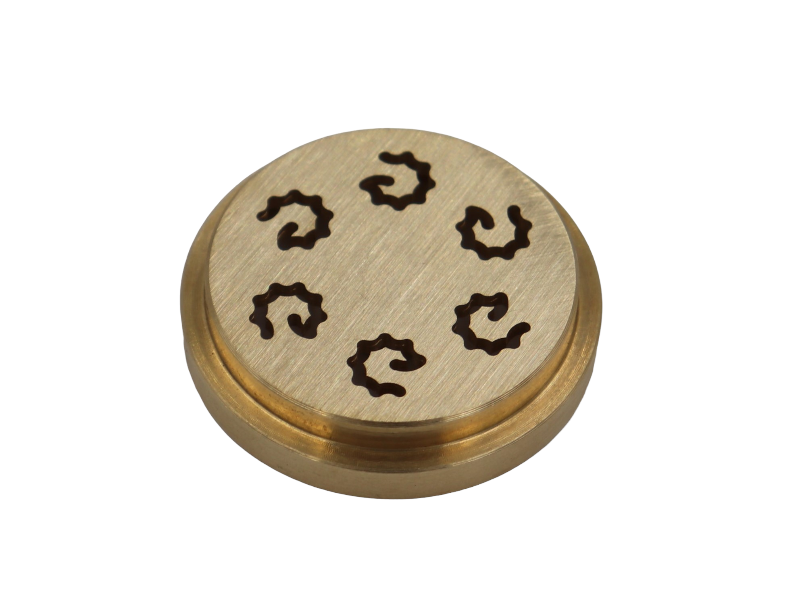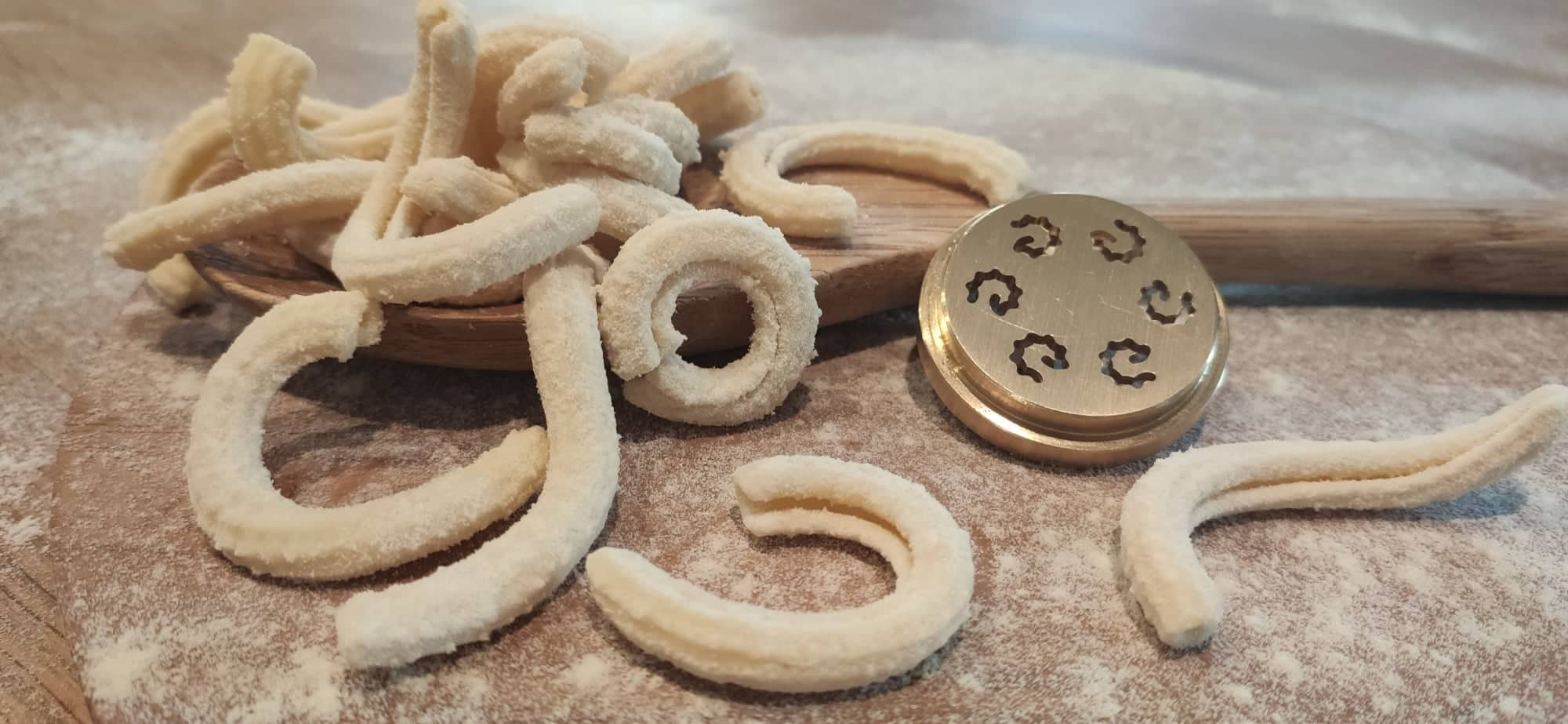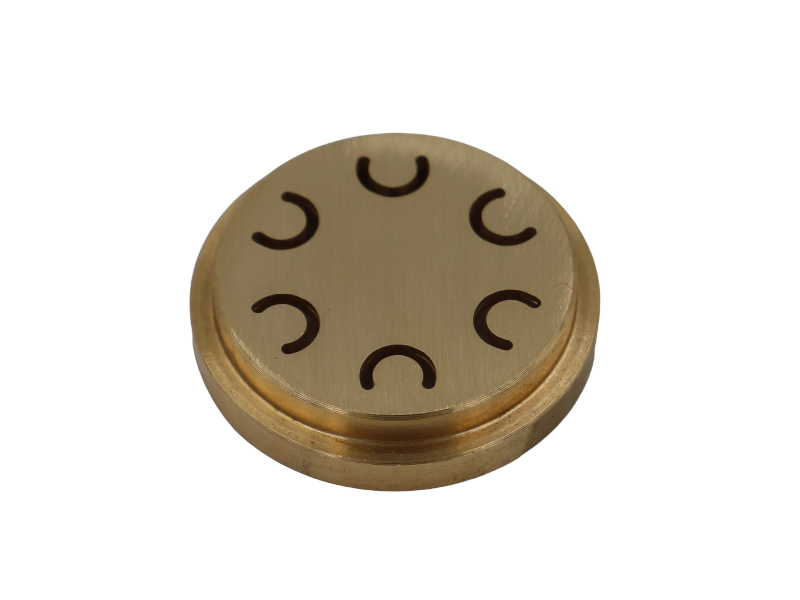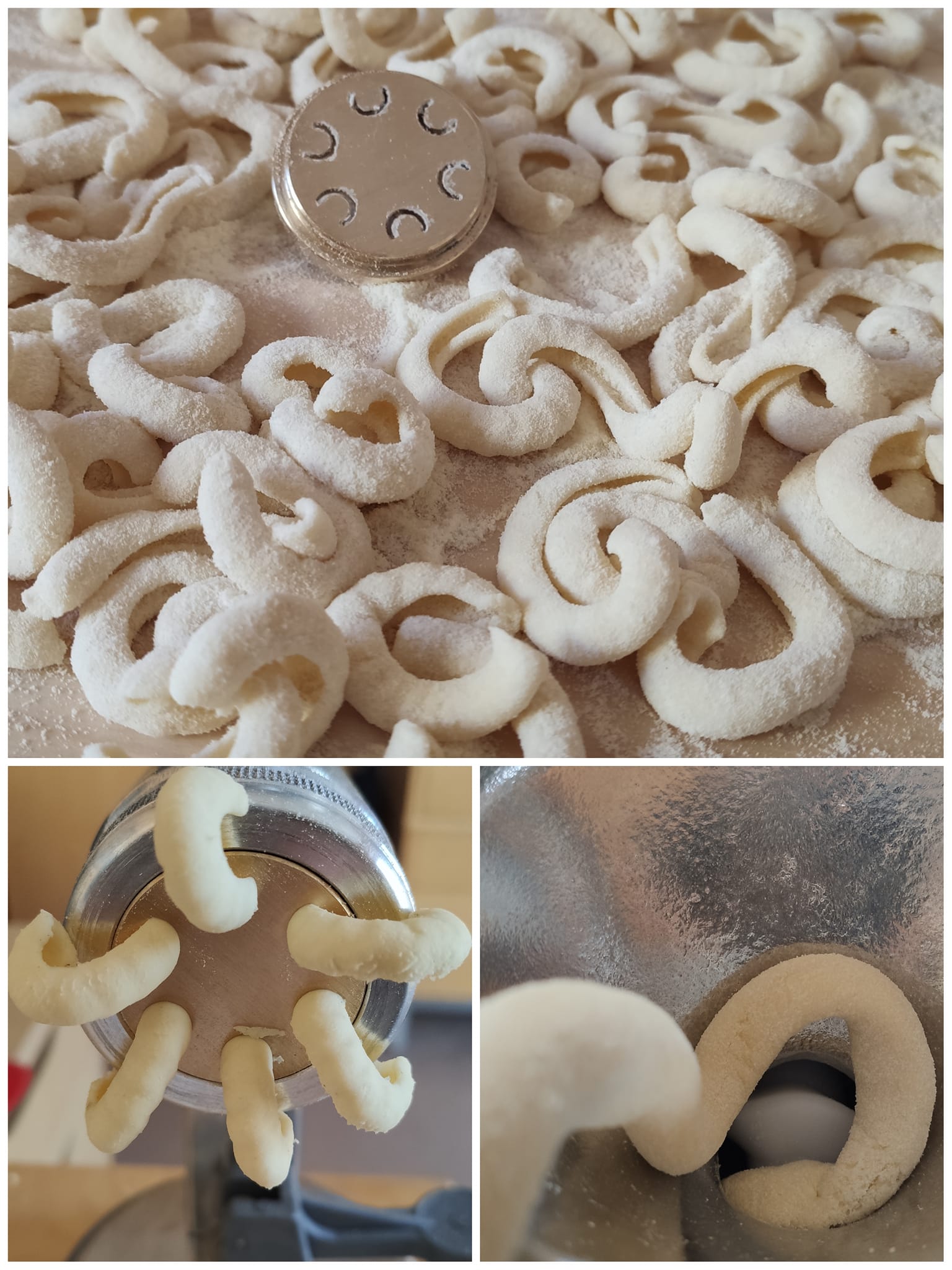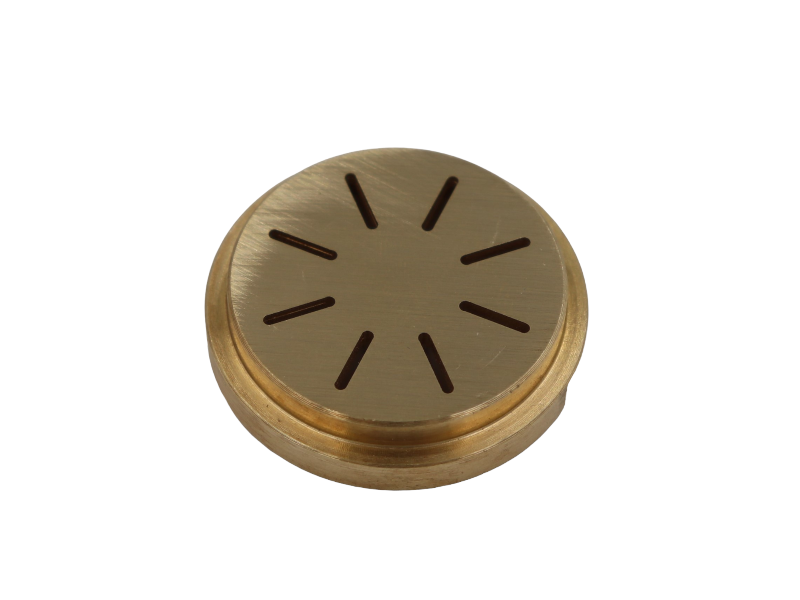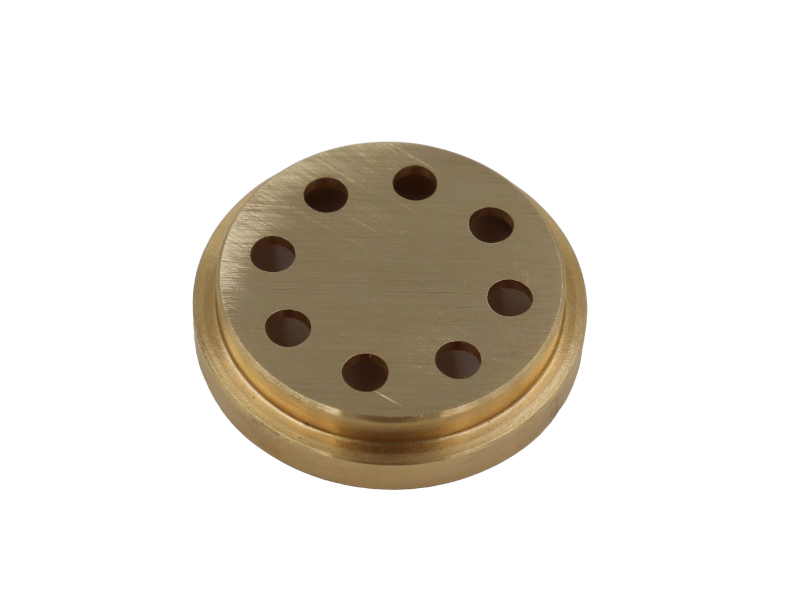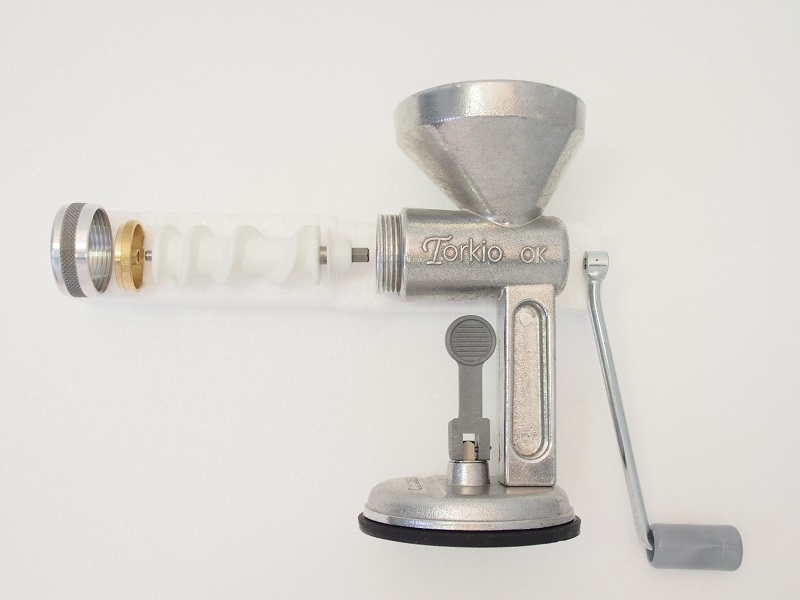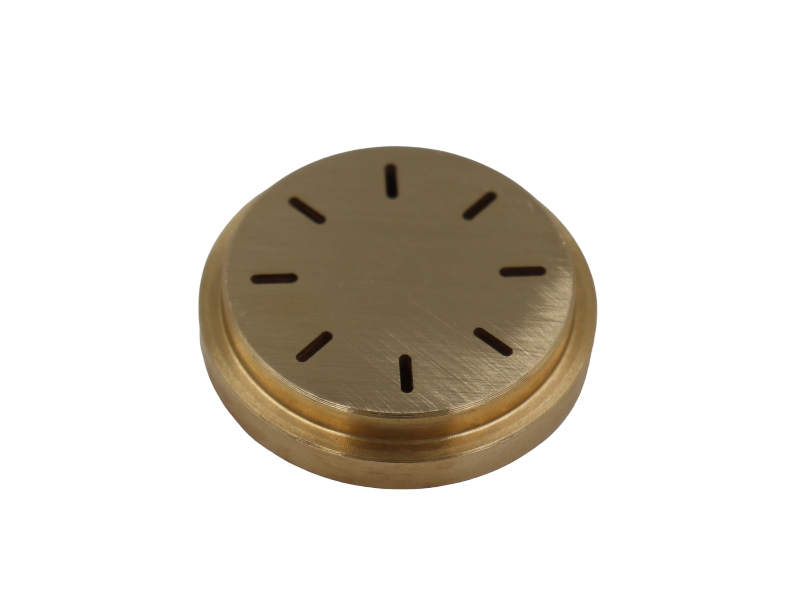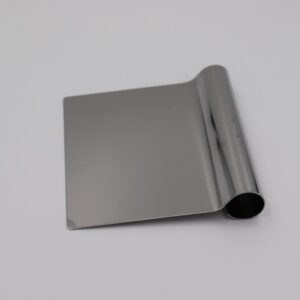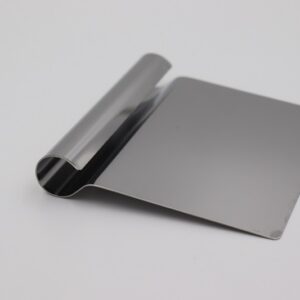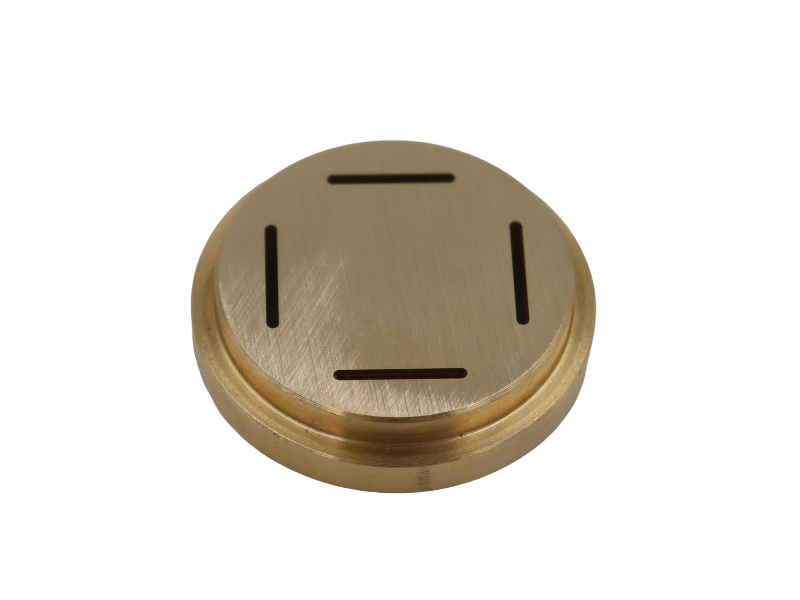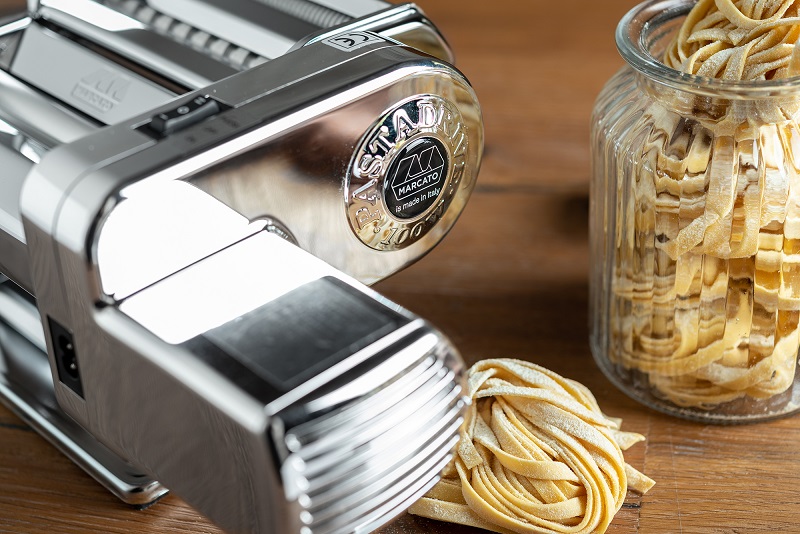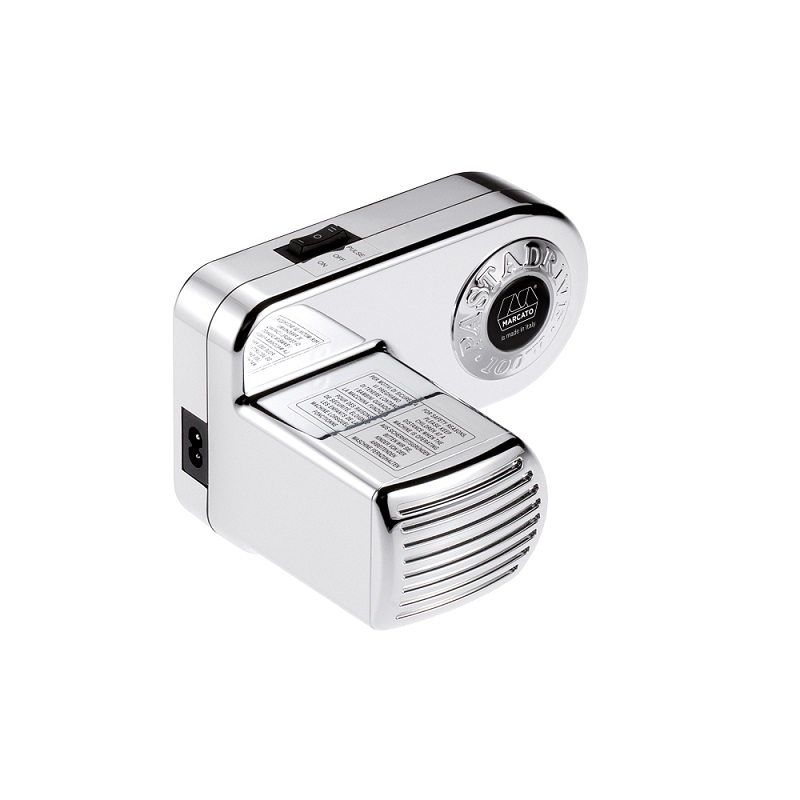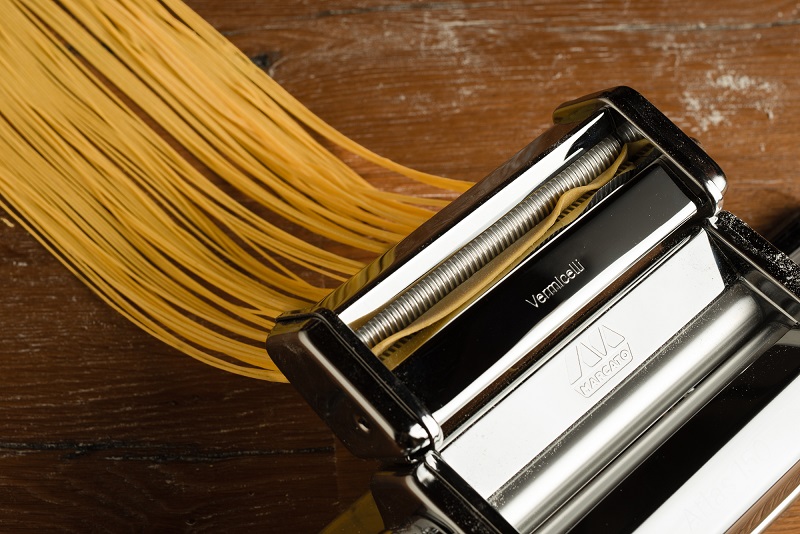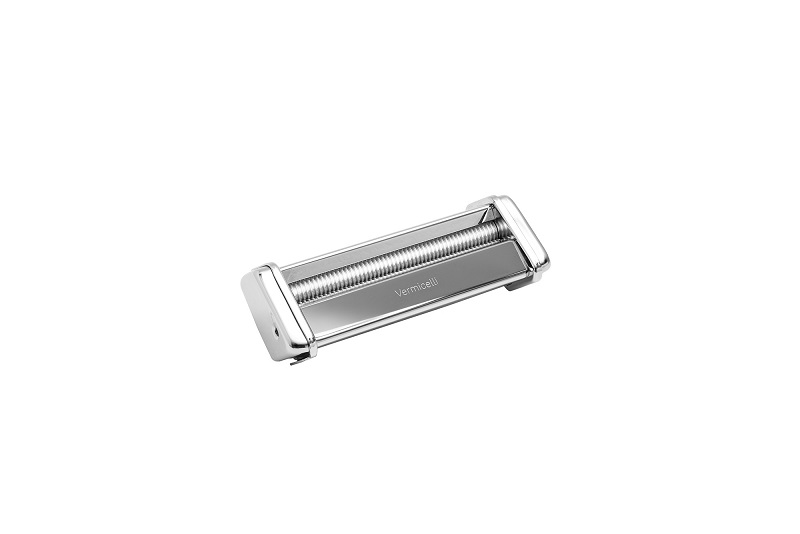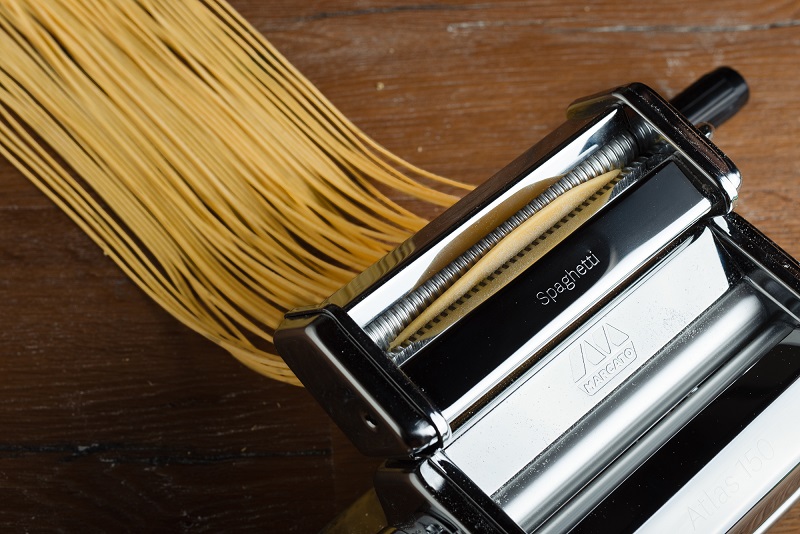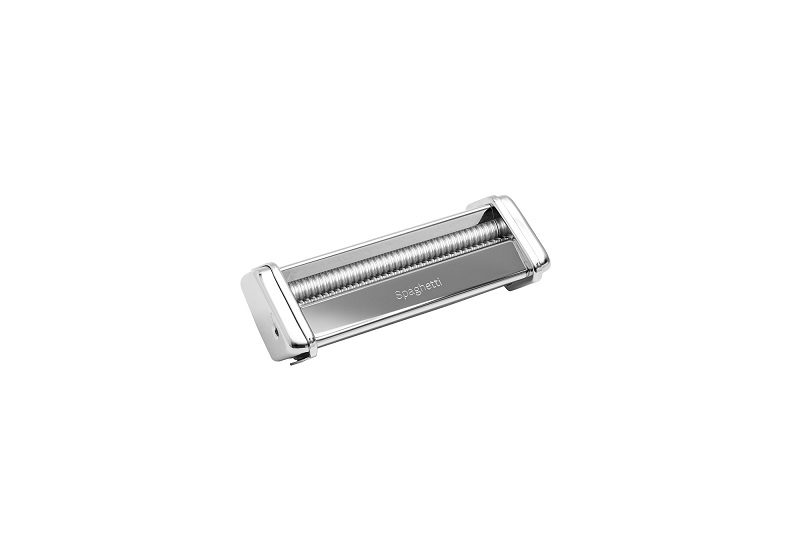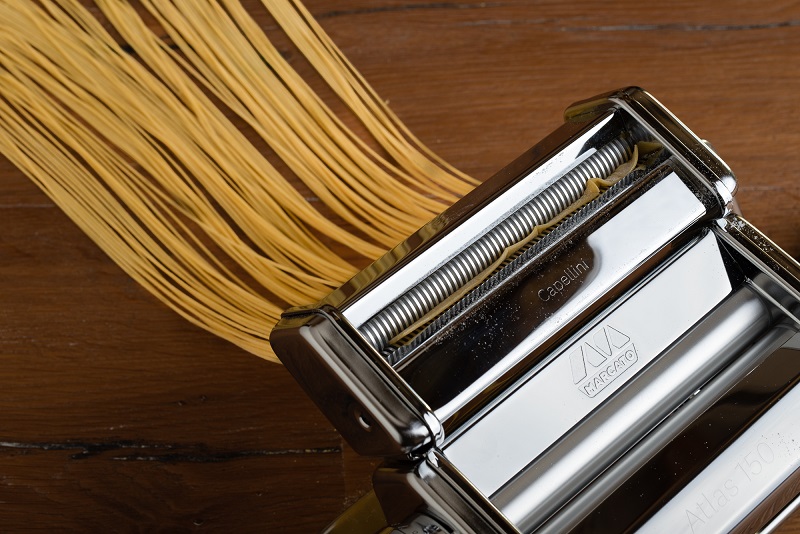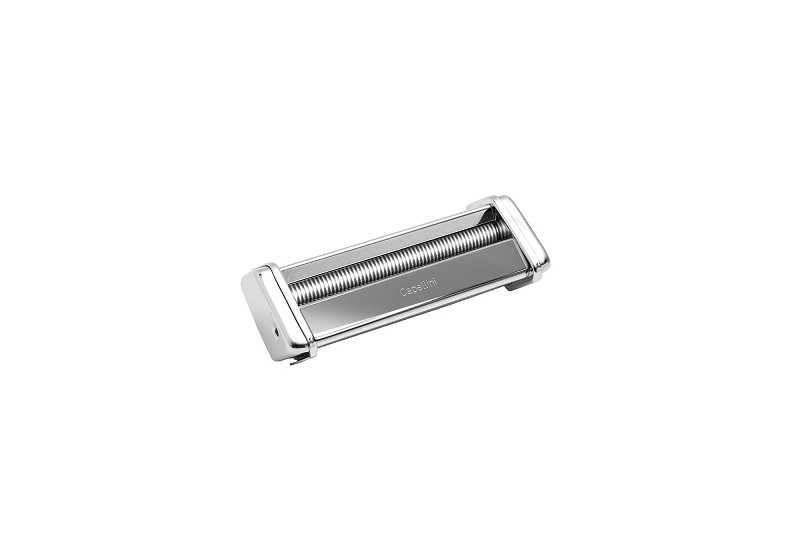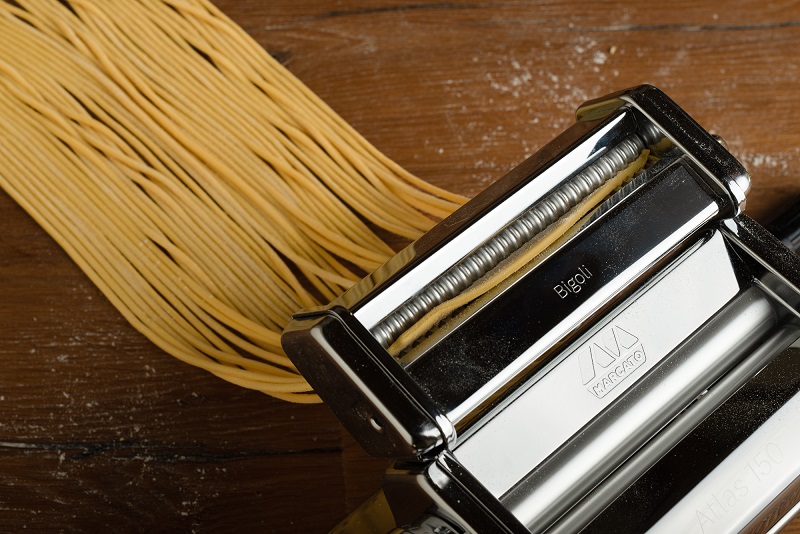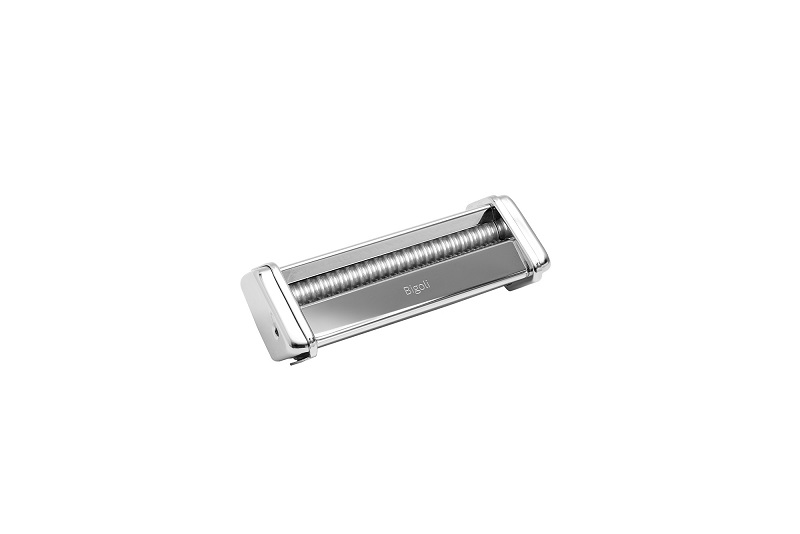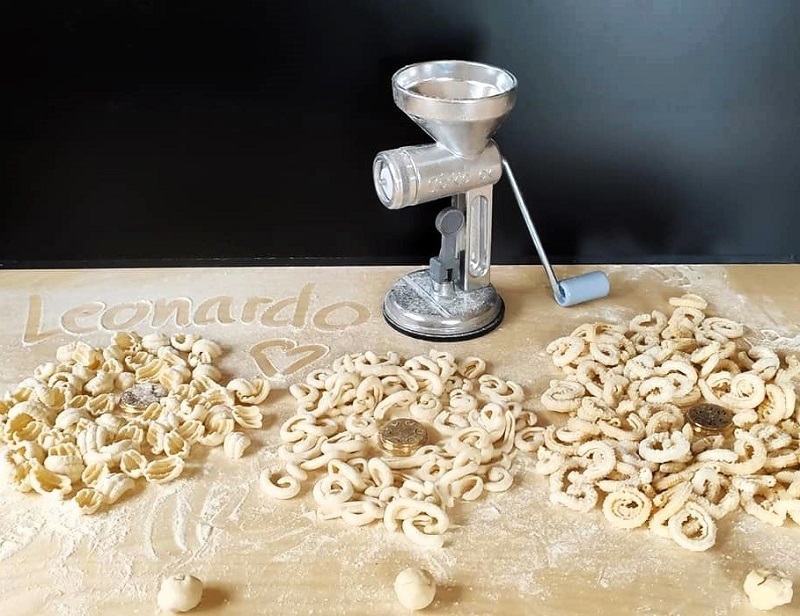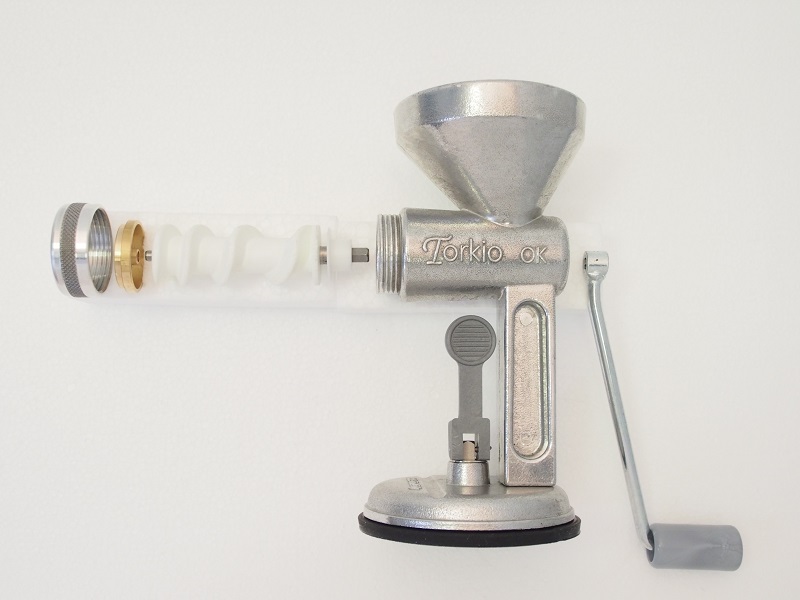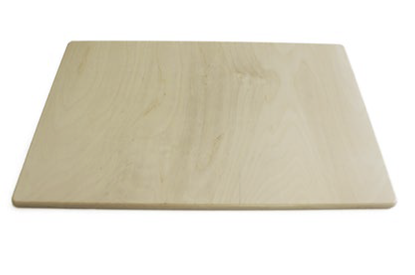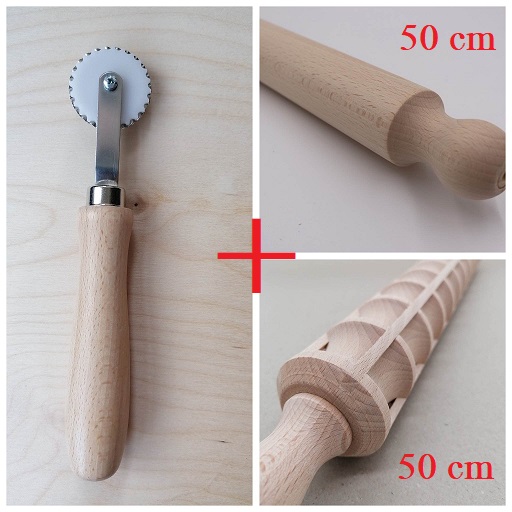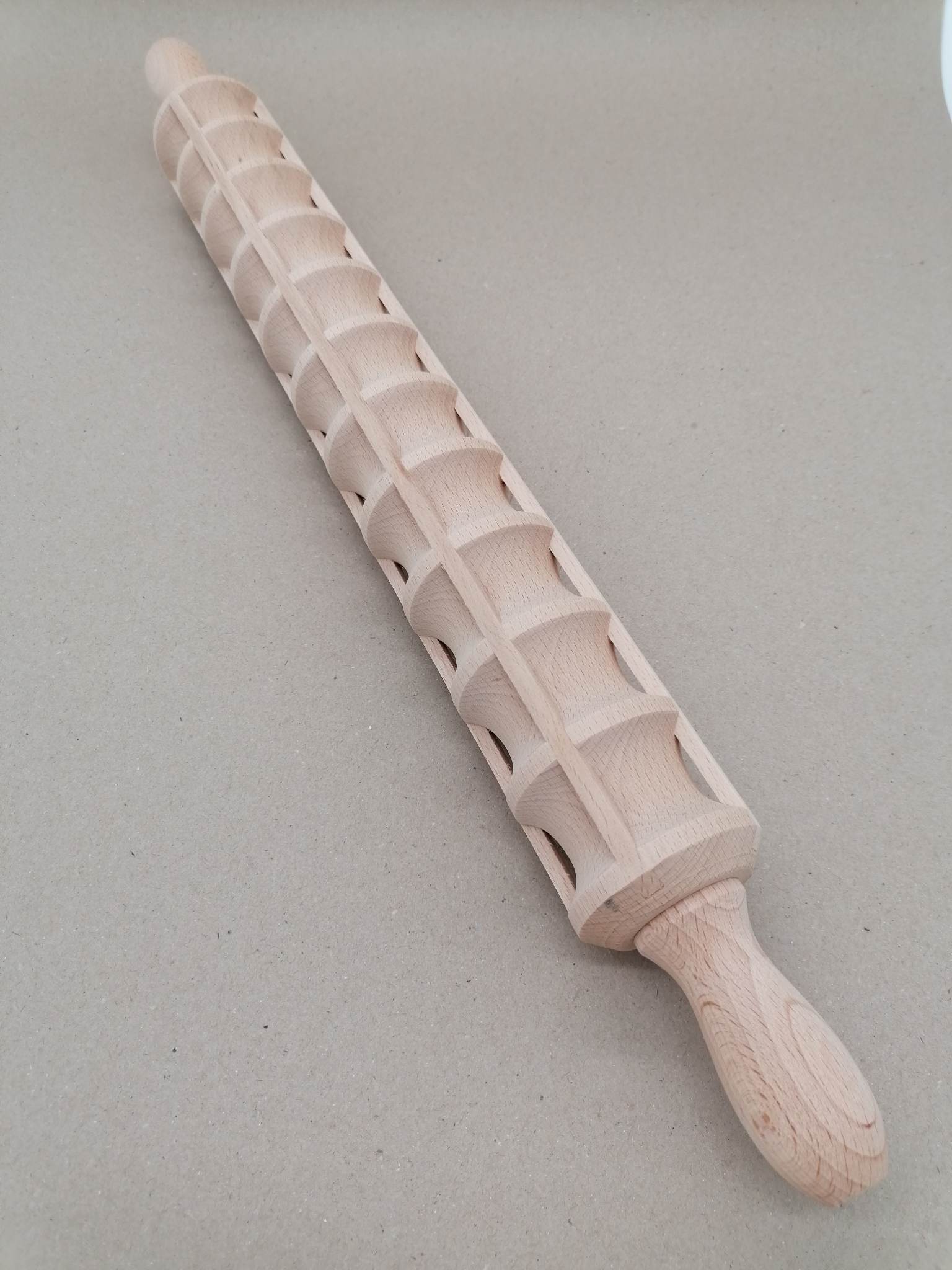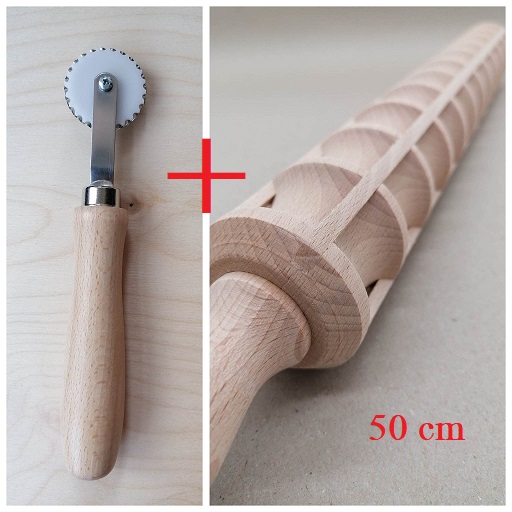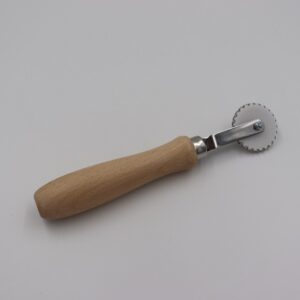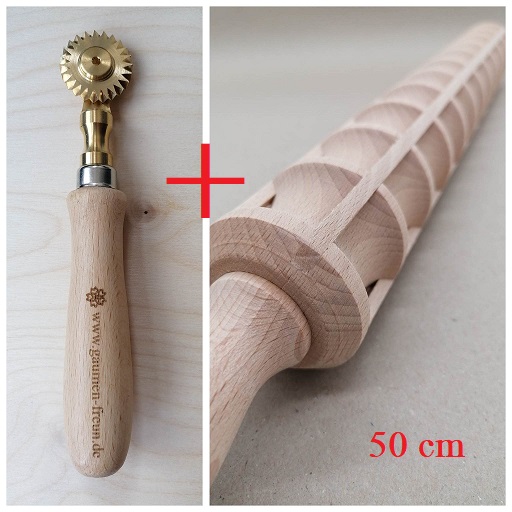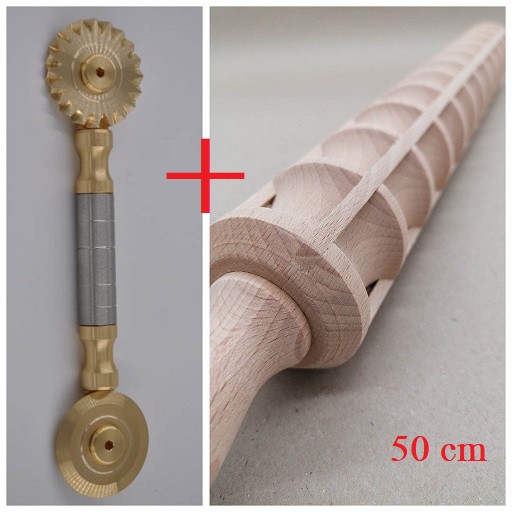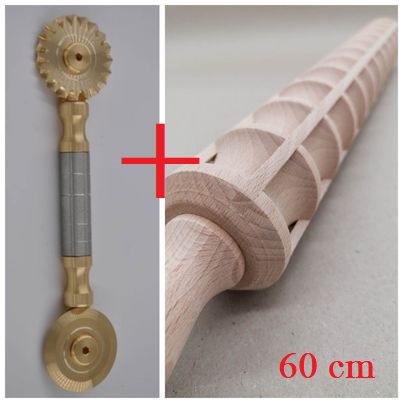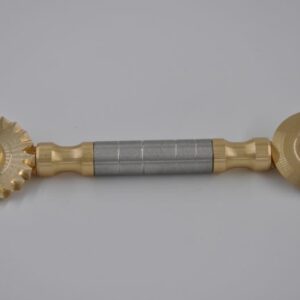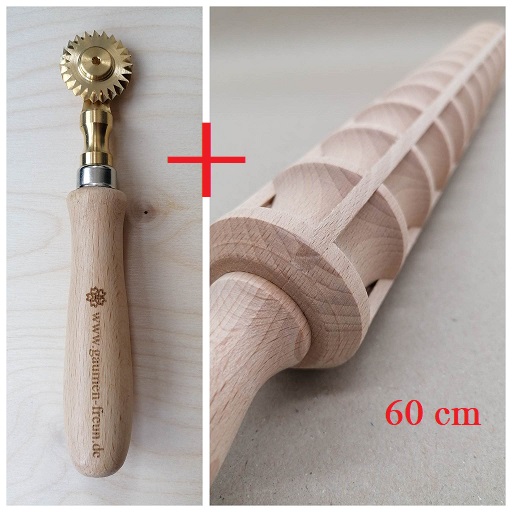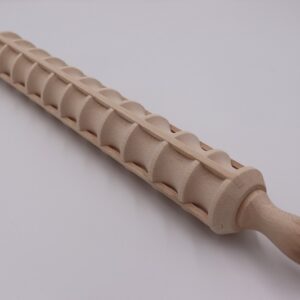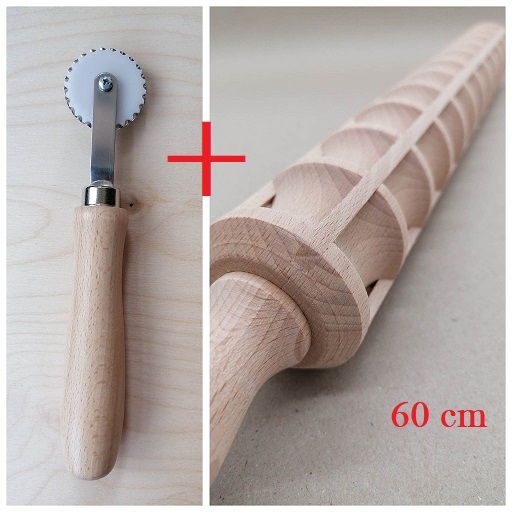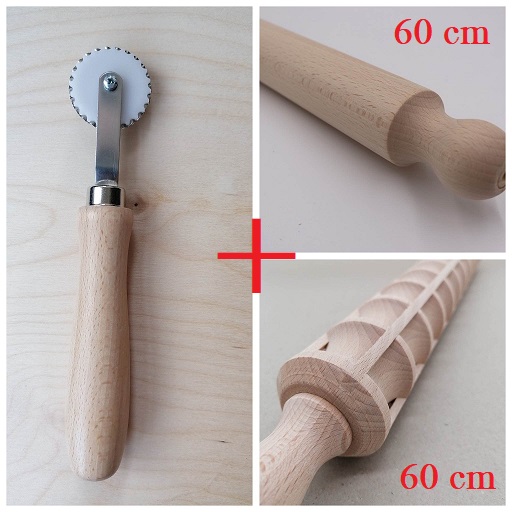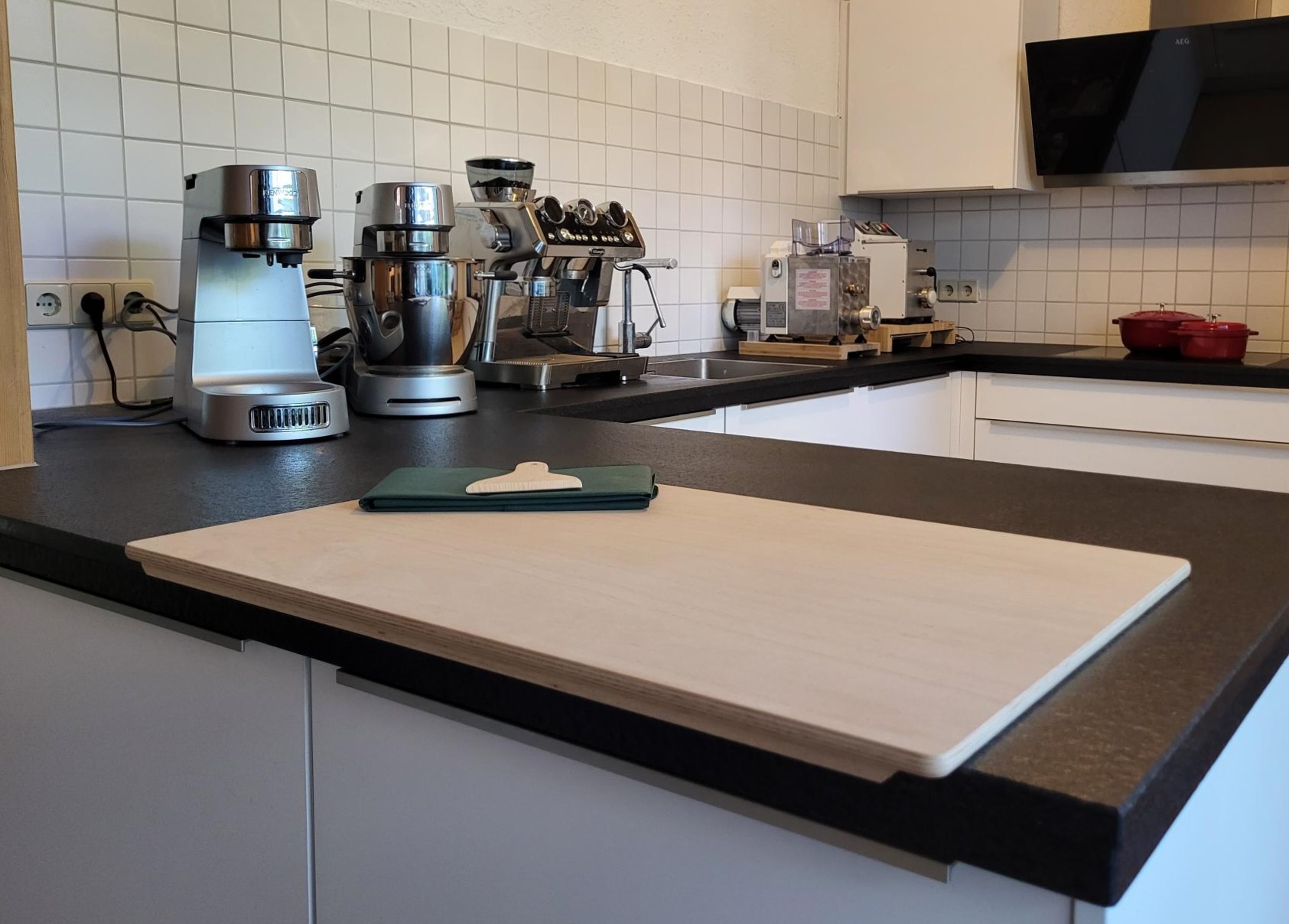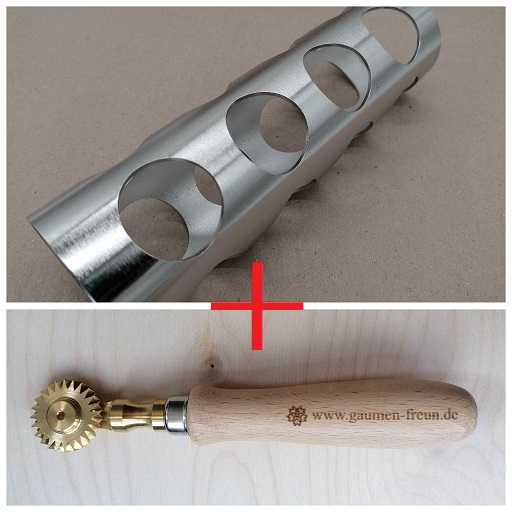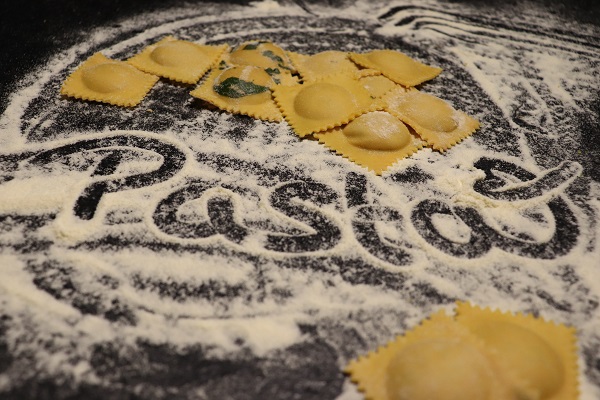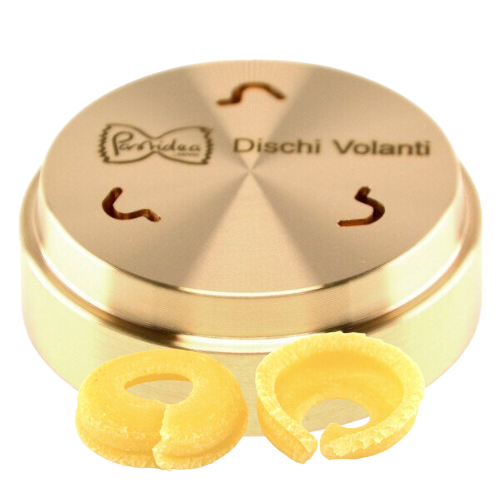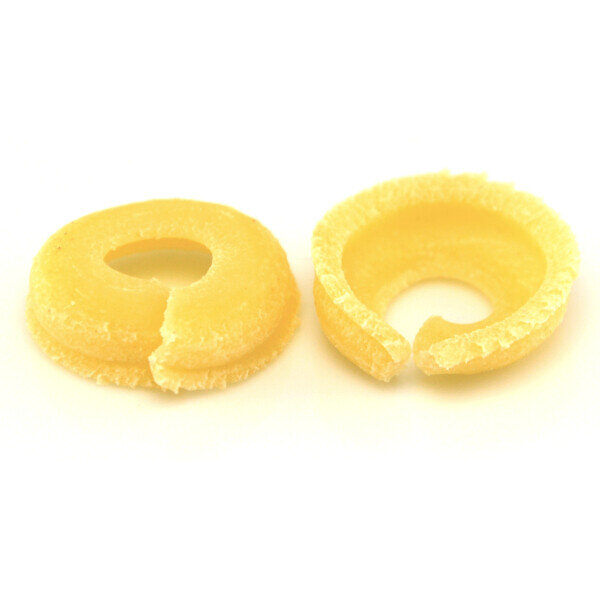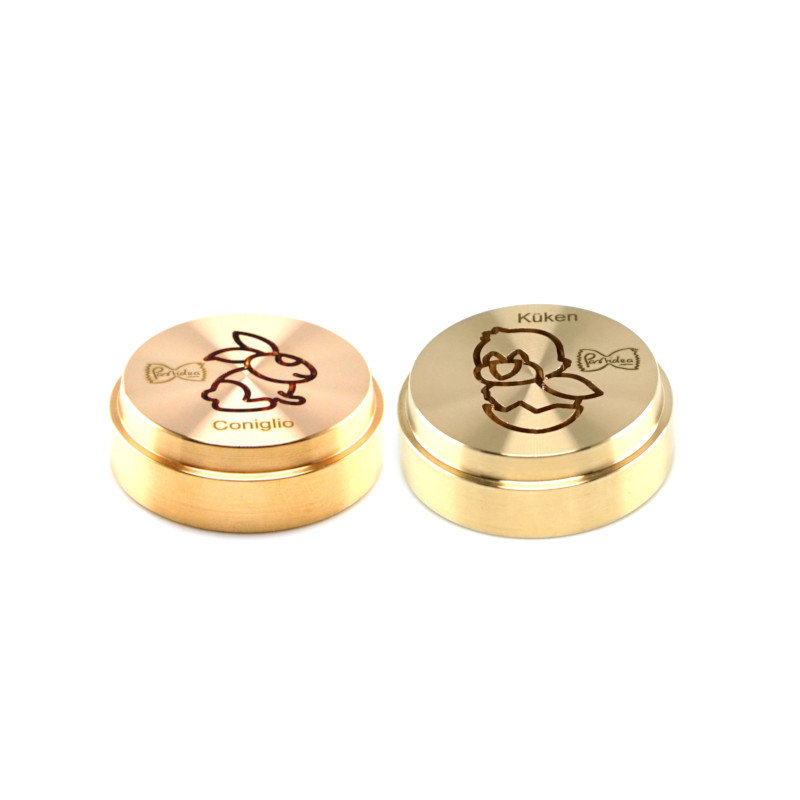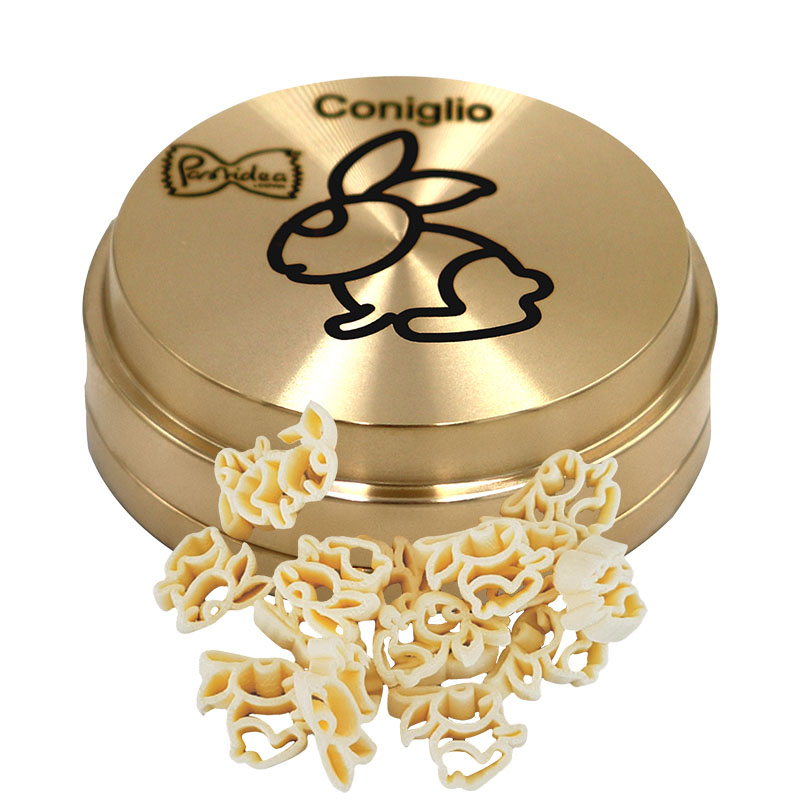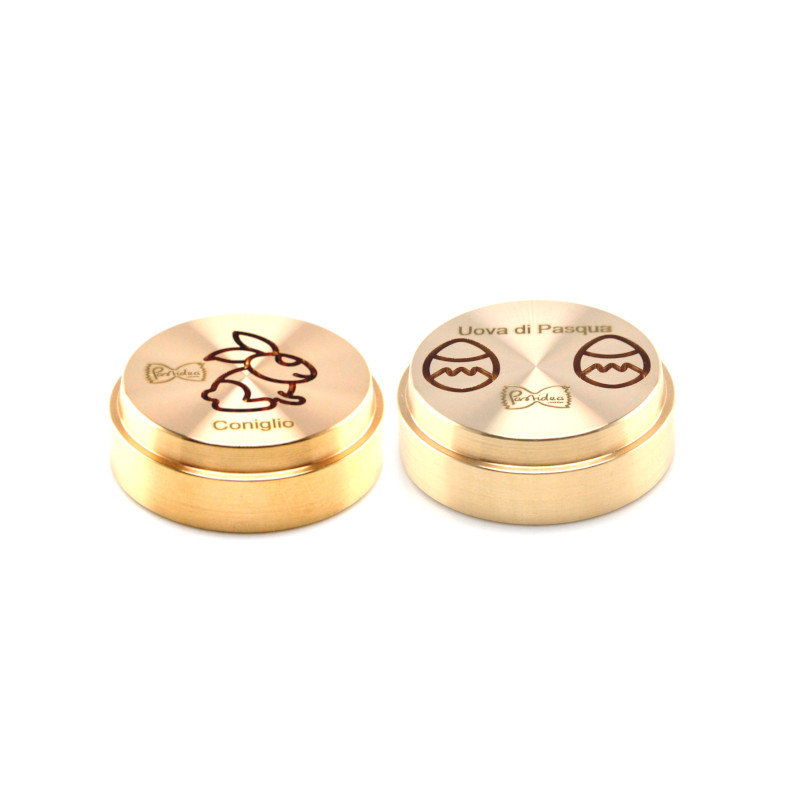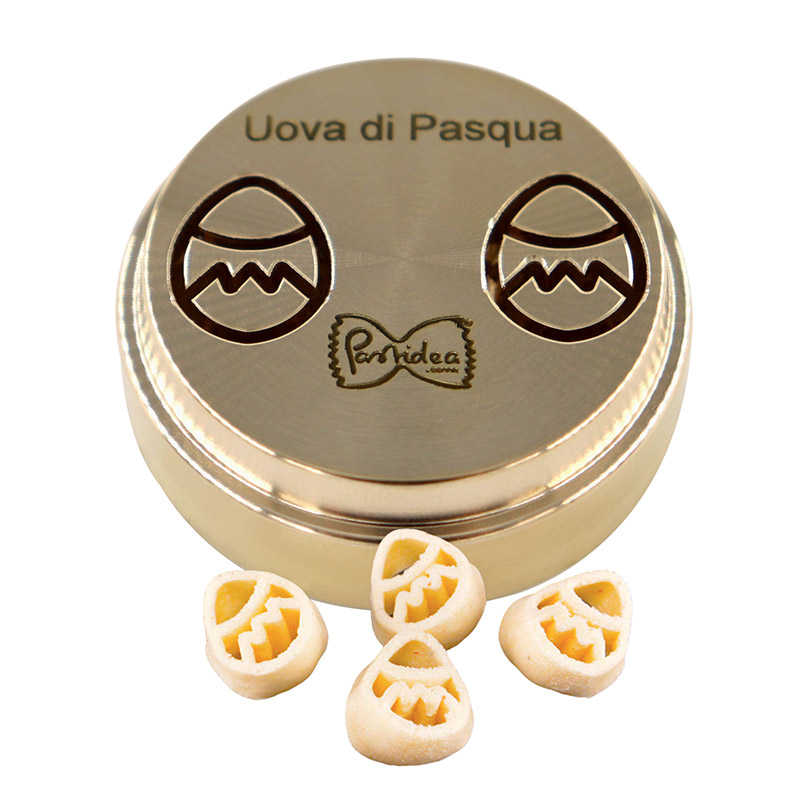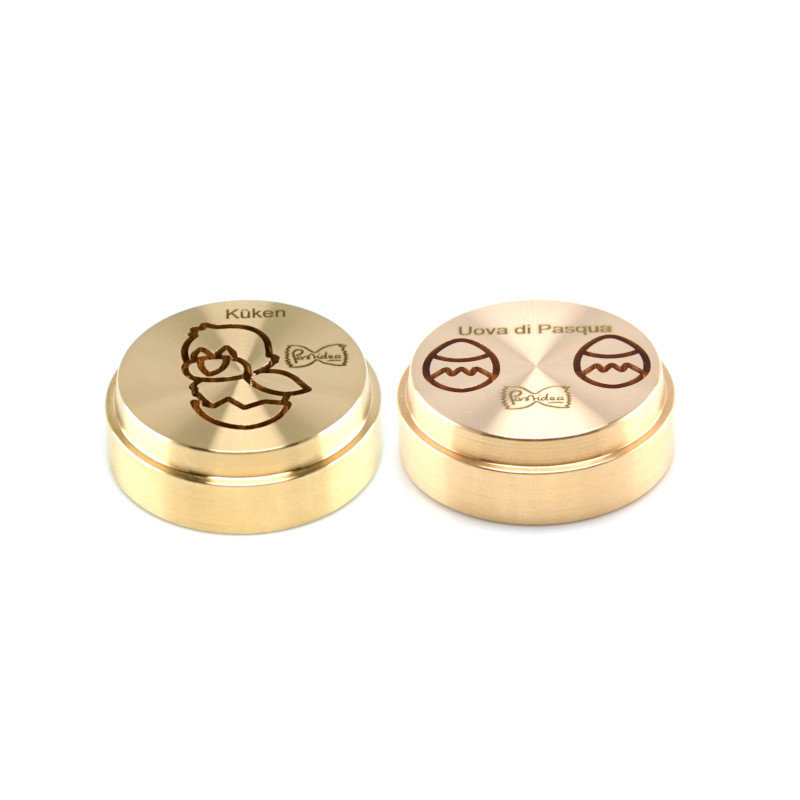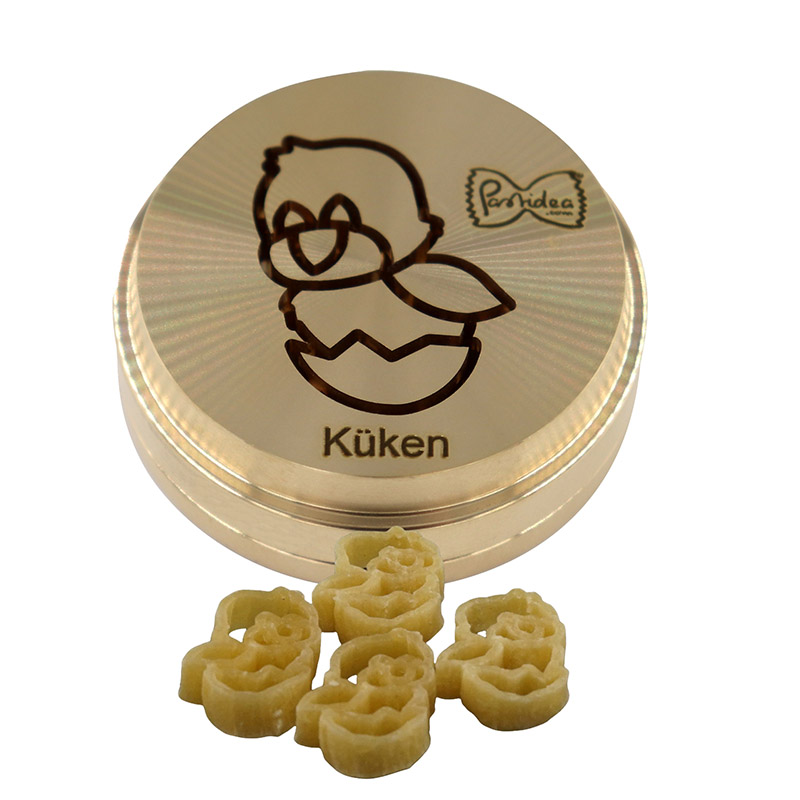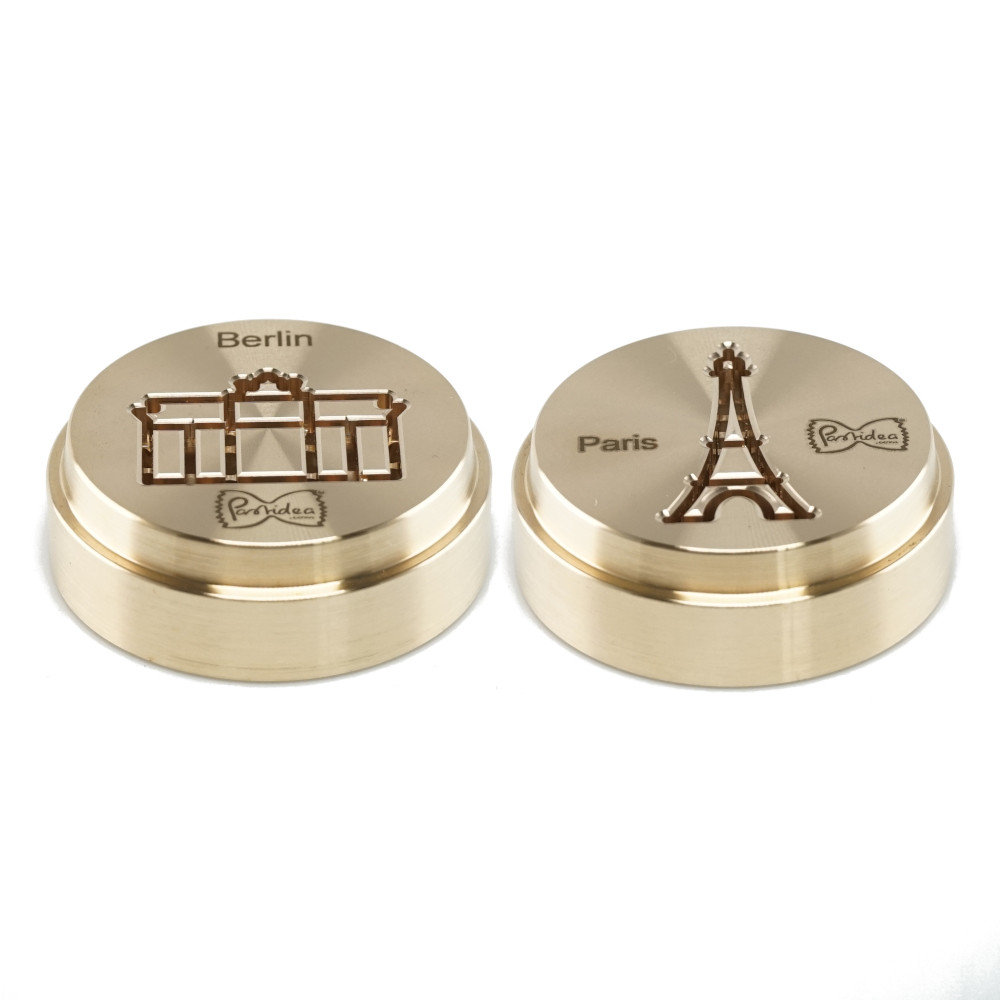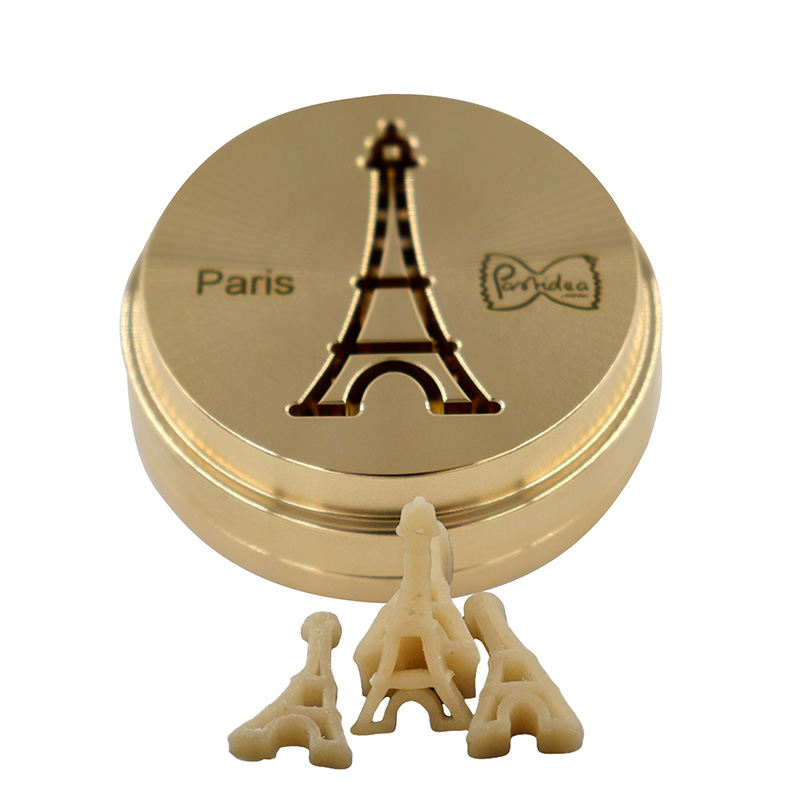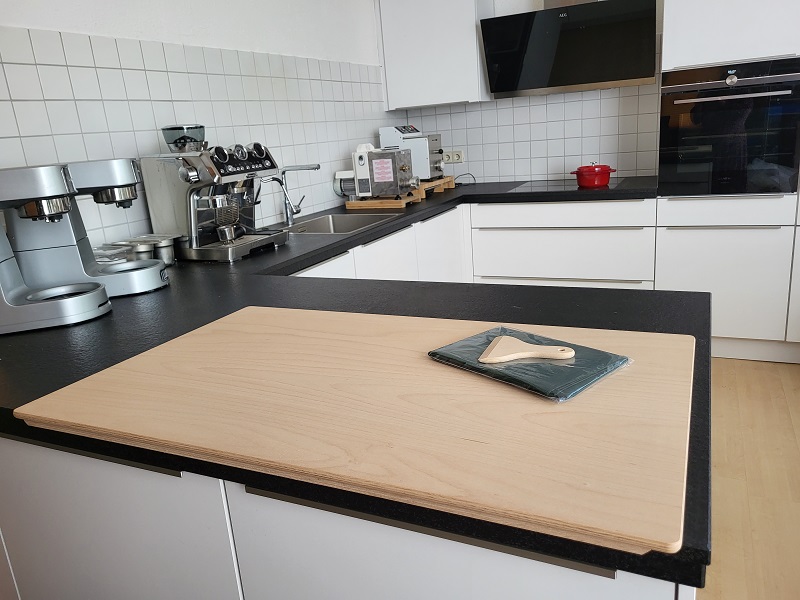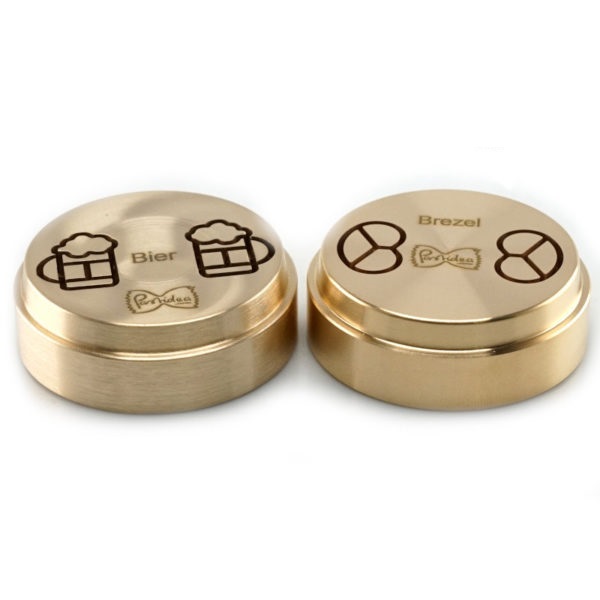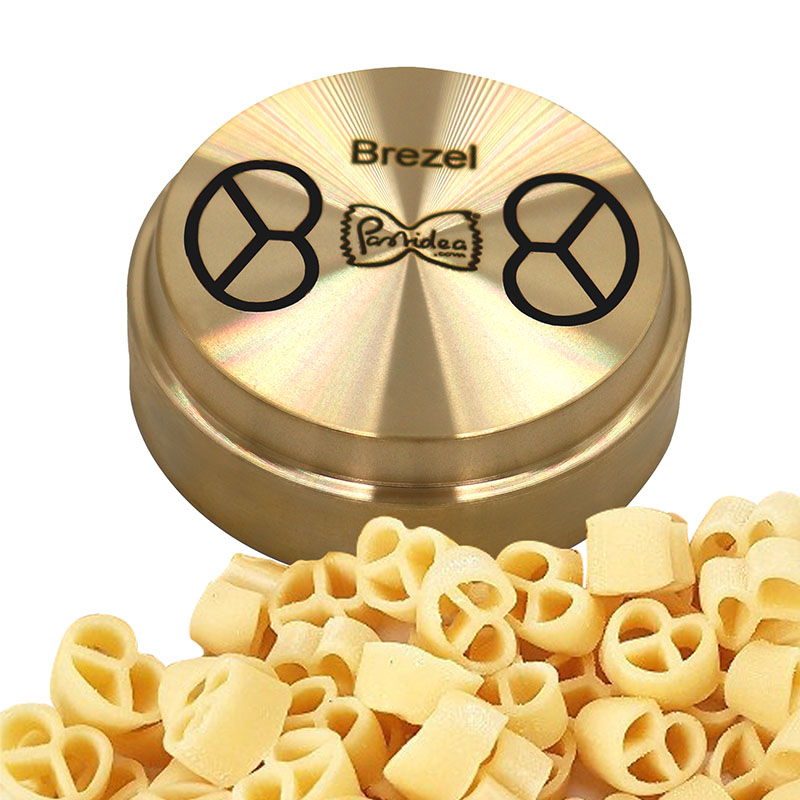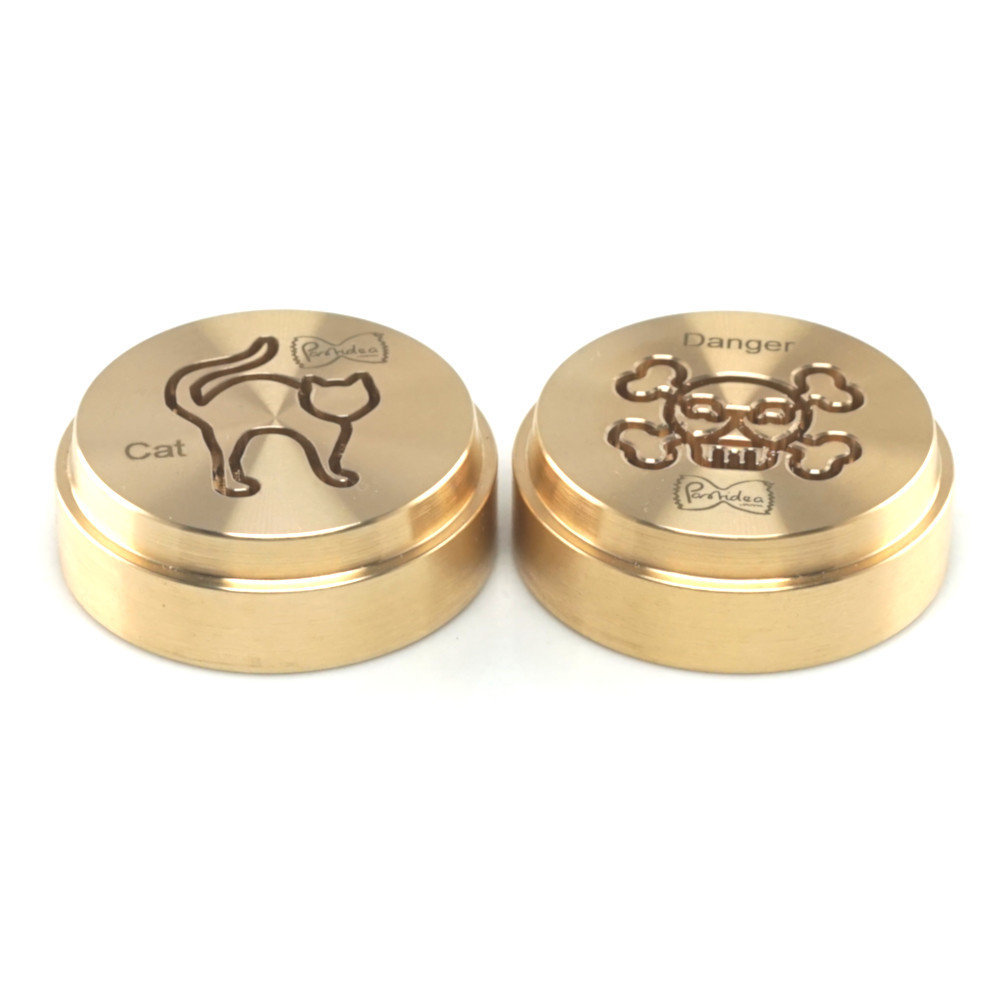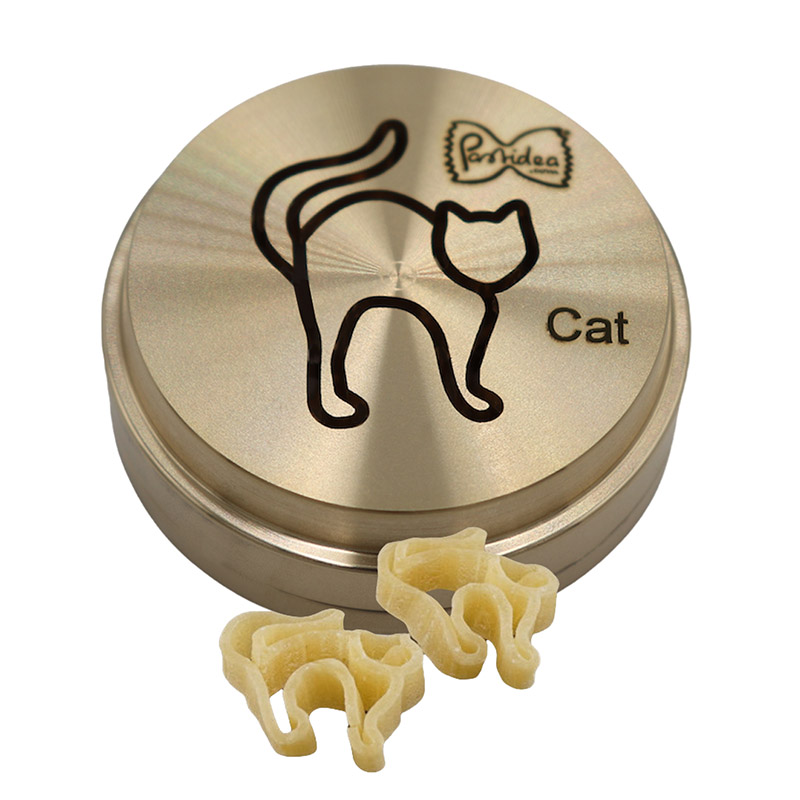15,90 € incl. VAT plus shipping costs
VAT included
excl. Shipping Rate
Pasta insert for the Leonardo - Torkio OK hand crank machine Torchietti Die only suitable for this pasta press! Why bronze: Bronze matrices were the traditional way of making pasta. The pasta made “al bronzo” can only be found rarely and usually only in selected delicatessens. By pressing the pasta dough through the bronze dies, the surface of the pasta is slightly roughened and the pasta becomes more grippy. This allows the pasta to absorb the sauce, flavors and spices better later. Storage: Do you have several bronze matrices and are you looking for storage to protect the matrix from dust and darkening due to the effects of light? Then we recommend our storage systems, which you can also find in our range.
15,90 € incl. VAT plus shipping costs
VAT included
excl. Shipping Rate
Pasta insert for the Leonardo - Torkio OK hand crank machine Spaccatelli Die only suitable for this pasta press! Why bronze: Bronze matrices were the traditional way of making pasta. The pasta made “al bronzo” can only be found rarely and usually only in selected delicatessens. By pressing the pasta dough through the bronze dies, the surface of the pasta is slightly roughened and the pasta becomes more grippy. This allows the pasta to absorb the sauce, flavors and spices better later. Storage: Do you have several bronze matrices and are you looking for storage to protect the matrix from dust and darkening due to the effects of light? Then we recommend our storage systems, which you can also find in our range.
15,90 € incl. VAT plus shipping costs
VAT included
excl. Shipping Rate
Pasta insert for the Leonardo - Torkio OK hand crank machine Tagliatelle are traditionally prepared with eggs in Emilia Romagna, Italy. The name comes from the Italian verb “tagliare”, which means “to cut”. i.e. Tagliatelle is pasta cut into strips. While in Germany Bolognese is traditionally eaten as “spaghetti Bolognese”, in Italy it is traditionally eaten as a Bolognese sauce together with tagliatelle. Try it out! Die only suitable for this pasta press! Why bronze: Bronze matrices were the traditional way of making pasta. The pasta made “al bronzo” can only be found rarely and usually only in selected delicatessens. By pressing the pasta dough through the bronze dies, the surface of the pasta is slightly roughened and the pasta becomes more grippy. This allows the pasta to absorb the sauce, flavors and spices better later. Storage: Do you have several bronze matrices and are you looking for storage to protect the matrix from dust and darkening due to the effects of light? Then we recommend our storage systems, which you can also find in our range.
15,90 € incl. VAT plus shipping costs
VAT included
excl. Shipping Rate
Pasta insert for the Leonardo - Torkio OK hand crank machine Diameter 4,5 mm Passatelli are a soup insert. They are found primarily in Emilia-Romagna, Italy, but also in neighboring regions such as Urbino in the Marche region. Die only suitable for this pasta press! Why bronze: Bronze matrices were the traditional way of making pasta. The pasta made “al bronzo” can only be found rarely and usually only in selected delicatessens. By pressing the pasta dough through the bronze dies, the surface of the pasta is slightly roughened and the pasta becomes more grippy. This allows the pasta to absorb the sauce, flavors and spices better later. Storage: Do you have several bronze matrices and are you looking for storage to protect the matrix from dust and darkening due to the effects of light? Then we recommend our storage systems, which you can also find in our range.
15,90 € incl. VAT plus shipping costs
VAT included
excl. Shipping Rate
Pasta insert for the Leonardo - Torkio OK hand crank machine Tagliolini are thin ribbon noodles. Wider than capellini but not as wide as tagliatelle. The name comes from the Italian verb “tagliare”. Tagliare means “to cut” and the -ini at the end means that it is something small. So cut a strip of dough into many very small strips. This pasta shape is particularly widespread in the Italian regions of Molise, Piedmont and Emiglia-Romagna. Die only suitable for this pasta press! Why bronze: Bronze matrices were the traditional way of making pasta. The pasta made “al bronzo” can only be found rarely and usually only in selected delicatessens. By pressing the pasta dough through the bronze dies, the surface of the pasta is slightly roughened and the pasta becomes more grippy. This allows the pasta to absorb the sauce, flavors and spices better later. Storage: Do you have several bronze matrices and are you looking for storage to protect the matrix from dust and darkening due to the effects of light? Then we recommend our storage systems, which you can also find in our range.
9,90 € incl. VAT plus shipping costs
VAT included
excl. Shipping Rate
Dough card made of stainless steel with rolled handle - small An absolute must in every kitchen, in stable professional quality and versatile. The dough scraper is ideal for processing all types of dough, cleaning work surfaces, cutting pasta and much more. Material: Stainless steel Size: 116 x 120 mm
15,90 € incl. VAT plus shipping costs
VAT included
excl. Shipping Rate
Pasta insert for the Leonardo - Torkio OK hand crank machine Pappardelle (ribbon noodles a la “wedding noodles”) - isn't that a pretty name? I suspect the name comes from the Italian verb "pappare" - colloquially it means something like "to feed". Makes some sense too. I can never get enough of pappardelle and I devour it. Pappardelle are ultimately nothing more than tagliatelle, with the only difference being that they are much wider. While tagliatelle are usually between 6 and 8 mm wide, if they are a little over 1 cm wide they can be called pappardelle. Originally, these noodles were always prepared with eggs. But as always: Whatever you like and taste good is allowed. Die only suitable for this pasta press! Why bronze: Bronze matrices were the traditional way of making pasta. The pasta made “al bronzo” can only be found rarely and usually only in selected delicatessens. By pressing the pasta dough through the bronze dies, the surface of the pasta is slightly roughened and the pasta becomes more grippy. This allows the pasta to absorb the sauce, flavors and spices better later. Storage: Do you have several bronze matrices and are you looking for storage to protect the matrix from dust and darkening due to the effects of light? Then we recommend our storage systems, which you can also find in our range.
Original price was: €122,9095,30 €Current price is: €95,30. incl. VAT plus shipping costs
VAT included
excl. Shipping Rate
Motor "Pastadrive 220 V" for Marcato Atlas 150 Pastadrive is the engine for Atlas 150 that supports you in preparing fresh pasta. The bayonet connection guarantees quick and easier attachment of the motor. It also allows the machine to be used on any flat surface without having to be additionally attached. With its ergonomic shape that makes it easier to grasp and hold, and its performance and robustness, Pastadrive ensures you perfect stability during use. An accessory that combines practicality and practical use, while maintaining the naturalness of hand-prepared dishes. Attention: compatible for machines from 2013. Unfortunately, you cannot attach the motor to older machines.
Original price was: €36,9031,50 €Current price is: €31,50. incl. VAT plus shipping costs
VAT included
excl. Shipping Rate
Accessory Vermicelli 150
High-quality attachment for the "Atlas 150". Vermicelli (thread noodles) are a round pasta format with a diameter of 1 mm. The recommended dough sheet thickness is dial position #5 on the pasta machine.Material: alloy steel Size: 19 x 58 x 30 cmRecipe:- 250 g soft wheat flour type “00”
- 250 g durum wheat flour (semolina flour)
- 5 whole eggs and water (250g total)
Original price was: €36,9031,50 €Current price is: €31,50. incl. VAT plus shipping costs
VAT included
excl. Shipping Rate
Accessory Spaghetti 150
High-quality attachment for the "Atlas 150". Spaghetti is a round noodle format with a diameter of 2 mm. The recommended dough sheet thickness is dial position #4 on the pasta machine.Material: alloy steel Size: 19 x 58 x 30 cmRecipe:- 250 g soft wheat flour type “00”
- 250 g durum wheat flour (semolina flour)
- 5 whole eggs and water (250g total)
Original price was: €36,9031,50 €Current price is: €31,50. incl. VAT plus shipping costs
VAT included
excl. Shipping Rate
Accessory Capellini 150
High-quality attachment for the "Atlas 150". The Capellini are a pasta format with a square diameter of 1 mm. The recommended dough sheet thickness is dial position #8 or 9 on the pasta machine. Material: alloy steel Size: 19 x 58 x 30 cmRecipe:- 250 g soft wheat flour type “00”
- 250 g durum wheat flour (semolina flour)
- 5 whole eggs and water (250g total)
Original price was: €36,9031,50 €Current price is: €31,50. incl. VAT plus shipping costs
VAT included
excl. Shipping Rate
Accessory Bigoli 150
High-quality attachment for the "Atlas 150". The bigoli are a round pasta format with a diameter of around 3,5 mm. The recommended dough sheet thickness is dial position #2 on the pasta machine. You can use it by hand with the accompanying hand crank or with the Pastadrive motor. Material: alloy steel Size: 19 x 58 x 30 cmRecipe:- 250 g soft wheat flour type “00”
- 250 g durum wheat flour (semolina flour)
- 5 whole eggs and water (250g total)
Original price was: €115,00100,00 €Current price is: €100,00. incl. VAT plus shipping costs
VAT included
excl. Shipping Rate
The manual pasta press - without electricity, without taking up much space!
In Italy, this mechanical pasta maker has long been an insider tip under the name "Torchio OK" or Torkio. It is now available on the non-Italian market (100% identical) as “Torchio Leonardo”. With this small hand crank machine you can produce fresh pasta in different formats in no time using bronze dies. The way it works is brilliantly simple. With the food processor (multi-chopper, Thermomix or similar) you produce a pasta dough from ingredients of your choice: E.g. water and durum wheat semolina or water, eggs and durum wheat semolina. The machine attaches well to most surfaces. If this doesn't work on the worktop, it often works better on the hob. You now fill the moist, crumbly dough into the filling chute and then all you have to do is crank and cut it off. The noodles are already ready. By the way, Leonardo is Divina's brother; they both come from the same family. The scope of delivery includes 3 bronze matrices (4 cm diameter, not compatible with Pastideamatrixes/Pastidea products) to produce the following formats: Spaccatelli (Shell) Tagliatelle (tape noodle) Torchietti (Tube noodle) (There are a variety of other matrices available for the machine, but these are not included in this set.) More technical data: The machine can be attached to most kitchen worktops using a suction cup base. The weight of Leonardo including the snail and cutter is just over 1 Kilo, so a real lightweight. The bowl can be easily unscrewed, so the pasta machine can be stored in a particularly space-saving manner. body: Food-safe die-cast aluminum slug and cutter: food-safe plastic 100% Made in Italy! The “Mady in Italy” is really the program here. If you are looking for a machine such as a Thermomix that is delivered without scratches or defects, this machine is not the right choice. It is a machine that has been produced in very small series by the Italian company Franceschi for many years. This means that it is not a mass-produced product; clear traces of production can be seen in the processing. As is often the case with Italian products, the machine is really ingenious, well thought out and functional. Care instructions: Please do not put the item in the dishwasher. Wiping with a damp cloth is sufficient.59,90 € incl. VAT plus shipping costs
VAT included
excl. Shipping Rate
Pastry board/working board made of birch wood Dimensions: approx. 100 x 60 x 1,2 cm Wood: multi-layered birch The dough board is ideal for kneading, rolling out and cutting all kinds of dough. Thanks to the stop bar on the front side (60 cm long). the board remains stable on the work surface and does not slip. A nice gift for all pasta lovers or if you want to spoil yourself. Natural product, different grains do not represent a defect. Care instructions: Do not immerse in water, do not leave under running water.
Original price was: €27,9726,97 €Current price is: €26,97. incl. VAT plus shipping costs
VAT included
excl. Shipping Rate
Magic wonder wood - Raviolatore Material: beech wood Length: 50 cm Diameter: 5 cm (1 turn of the ravioli wood makes 44 ravioli measuring 40×30 mm) There are many ways to make ravioli. The people of Sardinia have found a particularly efficient way to use their Sardinian miracle roll. This is how working with a ravioli rolling pin works: You roll out the pasta dough with a rolling pin. Ideally thinner than 1 mm, a thickness of approx. 0,5 mm - 0,8 mm is perfect. However, the thinner the dough, the easier it is to tear. In other words, it may be better not to start out quite so ambitiously at the beginning. With the rolling pin you can easily roll over the pasta track to draw a pattern. Place a spoonful of filling in the middle of each square. Now place a second sheet of pasta over it and roll it over it with the rolling pin. But this time with firm pressure. Cut off the ends of the ravioli with a pastry wheel. If the raviolis have not yet been separated by the firm pressure, use the dough wheel to separate the individual raviolis from each other. If you don't have a dough wheel yet, you can find them in various price ranges this Category: https://www.gaumen-freun.de/produkt-categorie/zubehoer/teigschneider/ However, most people work with the miracle wood in an even simpler way. You save the work of individual piles of filling and spread the filling over a large area on. In this Youtube video: https://www.youtube.com/watch?v=7qic32lfjgg&t=76s it is shown. This simple way actually works, try it out. Here is the recipe from Ellen Lutz (you can find the photo under this article):With this set you are perfectly prepared for the next ravioli production: the dough is prepared to the right size with the appropriate rolling pin, turned into ravioli with the magic wood and cut with the dough wheel - et voilà finished ravioli.Make a dough from 350 g Semola and 80 g pasta and tarte flambée flour (Semola and 00 mixed) and 150 g liquid (2 eggs, remaining water), 1 tbsp oil. Depending on the consistency, use a little more or less water.Filling: 300g freshly minced minced meat, 100g veal sausage meat, 1 egg. Salt, pepper, a few Italian herbs. Mix the mixture again in the multi-chopper.Spread the mixture on raw and proceed as in the video above.Attention: Please do not clean Wunderholz in the dishwasher, hand wash only. Clean with a damp cloth before first use. It is important to clean the rolling pin with a damp cloth promptly after use. Then it is best to place it vertically, i.e. vertically like a candle, to dry, away from sources of heat or moisture.Original price was: €20,9819,99 €Current price is: €19,99. incl. VAT plus shipping costs
VAT included
excl. Shipping Rate
Magic wonder wood - Raviolatore Material: beech wood Length: 50 cm Diameter: 5 cm (1 turn of the ravioli wood makes 44 ravioli measuring 40×30 mm) There are many ways to make ravioli. The people of Sardinia have found a particularly efficient way to use their Sardinian miracle roll. This is how working with a ravioli rolling pin works: You roll out the pasta dough with a rolling pin. Ideally thinner than 1 mm, a thickness of approx. 0,5 mm - 0,8 mm is perfect. However, the thinner the dough, the easier it is to tear. In other words, it may be better not to start out quite so ambitiously at the beginning. With the rolling pin you can easily roll over the pasta track to draw a pattern. Place a spoonful of filling in the middle of each square. Now place a second sheet of pasta over it and roll it over it with the rolling pin. But this time with firm pressure. Cut off the ends of the ravioli with a pastry wheel. If the raviolis have not yet been separated by the firm pressure, use the dough wheel to separate the individual raviolis from each other. If you don't have a dough wheel yet, you can find them in various price ranges this Category: https://www.gaumen-freun.de/produkt-categorie/zubehoer/teigschneider/ However, most people work with the miracle wood in an even simpler way. You save the work of individual piles of filling and spread the filling over a large area on. In this Youtube video: https://www.youtube.com/watch?v=7qic32lfjgg&t=76s it is shown. This simple way actually works, try it out. Here is the recipe from Ellen Lutz (you can find the photo under this article):With this set you are perfectly prepared for the next ravioli production: the ravioli are processed with the magic wood and cut through with the dough wheel - et voilà finished ravioli.Make a dough from 350 g Semola and 80 g pasta and tarte flambée flour (Semola and 00 mixed) and 150 g liquid (2 eggs, remaining water), 1 tbsp oil. Depending on the consistency, use a little more or less water.Filling: 300g freshly minced minced meat, 100g veal sausage meat, 1 egg. Salt, pepper, a few Italian herbs. Mix the mixture again in the multi-chopper.Spread the mixture on raw and proceed as in the video above.Attention: Please do not clean Wunderholz in the dishwasher, hand wash only. Clean with a damp cloth before first use. It is important to clean the rolling pin with a damp cloth promptly after use. Then it is best to place it vertically, i.e. vertically like a candle, to dry, away from sources of heat or moisture.Original price was: €36,8935,90 €Current price is: €35,90. incl. VAT plus shipping costs
VAT included
excl. Shipping Rate
Magic wonder wood - Raviolatore Material: beech wood Length: 50 cm Diameter: 5 cm (1 turn of the ravioli wood makes 44 ravioli measuring 40×30 mm) There are many ways to make ravioli. The people of Sardinia have found a particularly efficient way to use their Sardinian miracle roll. This is how working with a ravioli rolling pin works: You roll out the pasta dough with a rolling pin. Ideally thinner than 1 mm, a thickness of approx. 0,5 mm - 0,8 mm is perfect. However, the thinner the dough, the easier it is to tear. In other words, it may be better not to start out quite so ambitiously at the beginning. With the rolling pin you can easily roll over the pasta track to draw a pattern. Place a spoonful of filling in the middle of each square. Now place a second sheet of pasta over it and roll it over it with the rolling pin. But this time with firm pressure. Cut off the ends of the ravioli with a pastry wheel. If the raviolis have not yet been separated by the firm pressure, use the dough wheel to separate the individual raviolis from each other. If you don't have a dough wheel yet, you can find them in various price ranges this Category: https://www.gaumen-freun.de/produkt-categorie/zubehoer/teigschneider/ However, most people work with the miracle wood in an even simpler way. You save the work of individual piles of filling and spread the filling over a large area on. In this Youtube video: https://www.youtube.com/watch?v=7qic32lfjgg&t=76s it is shown. This simple way actually works, try it out. Here is the recipe from Ellen Lutz (you can find the photo under this article):With this set you are perfectly prepared for the next ravioli production: the ravioli are processed with the magic wood and cut through with the dough wheel - et voilà finished ravioli.By the way, brass has the great ability to push the dough away. This way the dough doesn't stick to the wheel ;)Make a dough from 350 g Semola and 80 g pasta and tarte flambée flour (Semola and 00 mixed) and 150 g liquid (2 eggs, remaining water), 1 tbsp oil. Depending on the consistency, use a little more or less water.Filling: 300g freshly minced minced meat, 100g veal sausage meat, 1 egg. Salt, pepper, a few Italian herbs. Mix the mixture again in the multi-chopper.Spread the mixture on raw and proceed as in the video above.Attention: Please do not clean Wunderholz in the dishwasher, hand wash only. Clean with a damp cloth before first use. It is important to clean the rolling pin with a damp cloth promptly after use. Then it is best to place it vertically, i.e. vertically like a candle, to dry, away from sources of heat or moisture.Original price was: €46,8945,89 €Current price is: €45,89. incl. VAT plus shipping costs
VAT included
excl. Shipping Rate
Magic wonder wood - Raviolatore Material: beech wood Length: 50 cm Diameter: 5 cm (1 turn of the ravioli wood makes 44 ravioli measuring 40×30 mm) There are many ways to make ravioli. The people of Sardinia have found a particularly efficient way to use their Sardinian miracle roll. This is how working with a ravioli rolling pin works: You roll out the pasta dough with a rolling pin. Ideally thinner than 1 mm, a thickness of approx. 0,5 mm - 0,8 mm is perfect. However, the thinner the dough, the easier it is to tear. In other words, it may be better not to start out quite so ambitiously at the beginning. With the rolling pin you can easily roll over the pasta track to draw a pattern. Place a spoonful of filling in the middle of each square. Now place a second sheet of pasta over it and roll it over it with the rolling pin. But this time with firm pressure. Cut off the ends of the ravioli with a pastry wheel. If the raviolis have not yet been separated by the firm pressure, use the dough wheel to separate the individual raviolis from each other. If you don't have a dough wheel yet, you can find them in various price ranges this Category: https://www.gaumen-freun.de/produkt-categorie/zubehoer/teigschneider/ However, most people work with the miracle wood in an even simpler way. You save the work of individual piles of filling and spread the filling over a large area on. In this Youtube video: https://www.youtube.com/watch?v=7qic32lfjgg&t=76s it is shown. This simple way actually works, try it out. Here is the recipe from Ellen Lutz (you can find the photo under this article):With this set you are perfectly prepared for the next ravioli production: the ravioli are processed with the magic wood and cut through with the dough wheel - et voilà finished ravioli.By the way, brass has the great ability to push the dough away. This way the dough doesn't stick to the wheel ;) And with this dough wheel you have both: smooth and wavy.Make a dough from 350 g Semola and 80 g pasta and tarte flambée flour (Semola and 00 mixed) and 150 g liquid (2 eggs, remaining water), 1 tbsp oil. Depending on the consistency, use a little more or less water.Filling: 300g freshly minced minced meat, 100g veal sausage meat, 1 egg. Salt, pepper, a few Italian herbs. Mix the mixture again in the multi-chopper.Spread the mixture on raw and proceed as in the video above.Attention: Please do not clean Wunderholz in the dishwasher, hand wash only. Clean with a damp cloth before first use. It is important to clean the rolling pin with a damp cloth promptly after use. Then it is best to place it vertically, i.e. vertically like a candle, to dry, away from sources of heat or moisture.Original price was: €46,8945,89 €Current price is: €45,89. incl. VAT plus shipping costs
VAT included
excl. Shipping Rate
Magic wonder wood - Raviolatore Material: beech wood Length: 60 cm Diameter: 5 cm (according to the manufacturer, 1 turn of the ravioli wood produces 40 ravioli in size 42x44 mm) There are many ways to make ravioli. The people of Sardinia have found a particularly efficient way to use their Sardinian miracle roll. This is how working with a ravioli rolling pin works: You roll out the pasta dough with a rolling pin. Ideally thinner than 1 mm, a thickness of approx. 0,5 mm - 0,8 mm is perfect. However, the thinner the dough, the easier it is to tear. In other words, it may be better not to start out quite so ambitiously at the beginning. With the rolling pin you can easily roll over the pasta track to draw a pattern. Place a spoonful of filling in the middle of each square. Now place a second sheet of pasta over it and roll it over it with the rolling pin. But this time with firm pressure. Cut off the ends of the ravioli with a pastry wheel. If the raviolis have not yet been separated by the firm pressure, use the dough wheel to separate the individual raviolis from each other. If you don't have a dough wheel yet, you can find them in various price ranges this Category: https://www.gaumen-freun.de/produkt-categorie/zubehoer/teigschneider/ However, most people work with the miracle wood in an even simpler way. You save the work of individual piles of filling and spread the filling over a large area on. In this Youtube video: https://www.youtube.com/watch?v=7qic32lfjgg&t=76s it is shown. This simple way actually works, try it out. Here is the recipe from Ellen Lutz (you can find the photo under this article):With this set you are perfectly prepared for the next ravioli production: the ravioli are processed with the magic wood and cut through with the dough wheel - et voilà finished ravioli.By the way, brass has the great ability to push the dough away. This way the dough doesn't stick to the wheel ;) And with this dough wheel you have both: smooth and wavy.Make a dough from 350 g Semola and 80 g pasta and tarte flambée flour (Semola and 00 mixed) and 150 g liquid (2 eggs, remaining water), 1 tbsp oil. Depending on the consistency, use a little more or less water.Filling: 300g freshly minced minced meat, 100g veal sausage meat, 1 egg. Salt, pepper, a few Italian herbs. Mix the mixture again in the multi-chopper.Spread the mixture on raw and proceed as in the video above.Attention: Please do not clean Wunderholz in the dishwasher, hand wash only. Clean with a damp cloth before first use. It is important to clean the rolling pin with a damp cloth promptly after use. Then it is best to place it vertically, i.e. vertically like a candle, to dry, away from sources of heat or moisture.Original price was: €36,8935,90 €Current price is: €35,90. incl. VAT plus shipping costs
VAT included
excl. Shipping Rate
Magic wonder wood - Raviolatore Material: beech wood Length: 60 cm Diameter: 5 cm (according to the manufacturer, 1 turn of the ravioli wood produces 40 ravioli in size 42x44 mm) There are many ways to make ravioli. The people of Sardinia have found a particularly efficient way to use their Sardinian miracle roll. This is how working with a ravioli rolling pin works: You roll out the pasta dough with a rolling pin. Ideally thinner than 1 mm, a thickness of approx. 0,5 mm - 0,8 mm is perfect. However, the thinner the dough, the easier it is to tear. In other words, it may be better not to start out quite so ambitiously at the beginning. With the rolling pin you can easily roll over the pasta track to draw a pattern. Place a spoonful of filling in the middle of each square. Now place a second sheet of pasta over it and roll it over it with the rolling pin. But this time with firm pressure. Cut off the ends of the ravioli with a pastry wheel. If the raviolis have not yet been separated by the firm pressure, use the dough wheel to separate the individual raviolis from each other. If you don't have a dough wheel yet, you can find them in various price ranges this Category: https://www.gaumen-freun.de/produkt-categorie/zubehoer/teigschneider/ However, most people work with the miracle wood in an even simpler way. You save the work of individual piles of filling and spread the filling over a large area on. In this Youtube video: https://www.youtube.com/watch?v=7qic32lfjgg&t=76s it is shown. This simple way actually works, try it out. Here is the recipe from Ellen Lutz (you can find the photo under this article):With this set you are perfectly prepared for the next ravioli production: the ravioli are processed with the magic wood and cut through with the dough wheel - et voilà finished ravioli.By the way, brass has the great ability to push the dough away. This way the dough doesn't stick to the wheel ;)Make a dough from 350 g Semola and 80 g pasta and tarte flambée flour (Semola and 00 mixed) and 150 g liquid (2 eggs, remaining water), 1 tbsp oil. Depending on the consistency, use a little more or less water.Filling: 300g freshly minced minced meat, 100g veal sausage meat, 1 egg. Salt, pepper, a few Italian herbs. Mix the mixture again in the multi-chopper.Spread the mixture on raw and proceed as in the video above.Attention: Please do not clean Wunderholz in the dishwasher, hand wash only. Clean with a damp cloth before first use. It is important to clean the rolling pin with a damp cloth promptly after use. Then it is best to place it vertically, i.e. vertically like a candle, to dry, away from sources of heat or moisture.Original price was: €20,9819,99 €Current price is: €19,99. incl. VAT plus shipping costs
VAT included
excl. Shipping Rate
Magic wonder wood - Raviolatore Material: beech wood Length: 60 cm Diameter: 5 cm (according to the manufacturer, 1 turn of the ravioli wood produces 40 ravioli in size 42x44 mm) There are many ways to make ravioli. The people of Sardinia have found a particularly efficient way to use their Sardinian miracle roll. This is how working with a ravioli rolling pin works: You roll out the pasta dough with a rolling pin. Ideally thinner than 1 mm, a thickness of approx. 0,5 mm - 0,8 mm is perfect. However, the thinner the dough, the easier it is to tear. In other words, it may be better not to start out quite so ambitiously at the beginning. With the rolling pin you can easily roll over the pasta track to draw a pattern. Place a spoonful of filling in the middle of each square. Now place a second sheet of pasta over it and roll it over it with the rolling pin. But this time with firm pressure. Cut off the ends of the ravioli with a pastry wheel. If the raviolis have not yet been separated by the firm pressure, use the dough wheel to separate the individual raviolis from each other. If you don't have a dough wheel yet, you can find them in various price ranges this Category: https://www.gaumen-freun.de/produkt-categorie/zubehoer/teigschneider/ However, most people work with the miracle wood in an even simpler way. You save the work of individual piles of filling and spread the filling over a large area on. In this Youtube video: https://www.youtube.com/watch?v=7qic32lfjgg&t=76s it is shown. This simple way actually works, try it out. Here is the recipe from Ellen Lutz (you can find the photo under this article):With this set you are perfectly prepared for the next ravioli production: the ravioli are processed with the magic wood and cut through with the dough wheel - et voilà finished ravioli.Make a dough from 350 g Semola and 80 g pasta and tarte flambée flour (Semola and 00 mixed) and 150 g liquid (2 eggs, remaining water), 1 tbsp oil. Depending on the consistency, use a little more or less water.Filling: 300g freshly minced minced meat, 100g veal sausage meat, 1 egg. Salt, pepper, a few Italian herbs. Mix the mixture again in the multi-chopper.Spread the mixture on raw and proceed as in the video above.Attention: Please do not clean Wunderholz in the dishwasher, hand wash only. Clean with a damp cloth before first use. It is important to clean the rolling pin with a damp cloth promptly after use. Then it is best to place it vertically, i.e. vertically like a candle, to dry, away from sources of heat or moisture.Original price was: €28,9727,90 €Current price is: €27,90. incl. VAT plus shipping costs
VAT included
excl. Shipping Rate
Magic wonder wood - Raviolatore Material: beech wood Length: 60 cm Diameter: 5 cm (according to the manufacturer, 1 turn of the ravioli wood produces 40 ravioli in size 42x44 mm) There are many ways to make ravioli. The people of Sardinia have found a particularly efficient way to use their Sardinian miracle roll. This is how working with a ravioli rolling pin works: You roll out the pasta dough with a rolling pin. Ideally thinner than 1 mm, a thickness of approx. 0,5 mm - 0,8 mm is perfect. However, the thinner the dough, the easier it is to tear. In other words, it may be better not to start out quite so ambitiously at the beginning. With the rolling pin you can easily roll over the pasta track to draw a pattern. Place a spoonful of filling in the middle of each square. Now place a second sheet of pasta over it and roll it over it with the rolling pin. But this time with firm pressure. Cut off the ends of the ravioli with a pastry wheel. If the raviolis have not yet been separated by the firm pressure, use the dough wheel to separate the individual raviolis from each other. If you don't have a dough wheel yet, you can find them in various price ranges this Category: https://www.gaumen-freun.de/produkt-categorie/zubehoer/teigschneider/ However, most people work with the miracle wood in an even simpler way. You save the work of individual piles of filling and spread the filling over a large area on. In this Youtube video: https://www.youtube.com/watch?v=7qic32lfjgg&t=76s it is shown. This simple way actually works, try it out. Here is the recipe from Ellen Lutz (you can find the photo under this article):With this set you are perfectly prepared for the next ravioli production: the dough is prepared to the right size with the appropriate rolling pin, turned into ravioli with the magic wood and cut with the dough wheel - et voilà finished ravioli.Make a dough from 350 g Semola and 80 g pasta and tarte flambée flour (Semola and 00 mixed) and 150 g liquid (2 eggs, remaining water), 1 tbsp oil. Depending on the consistency, use a little more or less water.Filling: 300g freshly minced minced meat, 100g veal sausage meat, 1 egg. Salt, pepper, a few Italian herbs. Mix the mixture again in the multi-chopper.Spread the mixture on raw and proceed as in the video above.Attention: Please do not clean Wunderholz in the dishwasher, hand wash only. Clean with a damp cloth before first use. It is important to clean the rolling pin with a damp cloth promptly after use. Then it is best to place it vertically, i.e. vertically like a candle, to dry, away from sources of heat or moisture.43,90 € incl. VAT plus shipping costs
VAT included
excl. Shipping Rate
Set of pasta board/work board 75 x 50 x 1,2 cm dough scraper and fabric bag pasta board beech 75 x 50 x 1,2 cm dough scraper real wood beech incl. green bag for storage. The dough board is ideal for kneading, rolling out and cutting all kinds of dough. Thanks to the stop bar at the front, the board lies stable on the work surface and does not slip. A nice gift for all pasta lovers or if you want to spoil yourself. Natural product, different grains do not represent a defect. Care instructions: Do not immerse in water, do not leave under running water.
Original price was: €53,9048,90 €Current price is: €48,90. incl. VAT plus shipping costs
VAT included
excl. Shipping Rate
The advantages of the material: Polished stainless steel - food quality. The material makes the product hygienic. Germs and bacteria don't stand a chance when cleaned in the dishwasher or rinsed with hot water. The product is odorless and aromaless. Thanks to the non-stick coating, the dough does not stick to the roller and you can work cleanly. Dishwasher-safe. Included in delivery is a dough wheel with a real wooden handle and a serrated brass blade, diameter 30 mm. With this dough wheel you can easily create a zigzag edge. This is how working with the ravioli roll works: Use the Kenwood XL roller to roll out the dough to the desired thickness. Depending on the dough, we recommend rolling up to level 7 or 8. However, the thinner the dough, the easier it is to tear. In other words, it may be better not to start out quite so ambitiously at the beginning. Spread the creamy filling on one half of the noodle ribbon. Leave a small border free. The filling must be creamy; we recommend using a spatula or palette to smooth out the filling. Now fold the other half of the dough over the filling. Position the roll and slowly roll it over the dough strip using gentle pressure. Now all you have to do is cut the ravioli with a pastry wheel and the ravioli are ready. Unpackaged: The ravioli roll comes with instructions for use. The delivery is unpackaged, without an outer box, for the sake of the environment. Note: The roll is perfect for creamy fillings. We recommend pureeing the filling in the Kenwood multi-chopper.Ravioleasy Kenwoodedition, length 21 cm, ravioli size approx. 5 x 5 cm The rolling BabGi Introductory price until September 25.09.2022th, XNUMX Material: Polished stainless steel with non-stick coating Length: 21 cm (Kenwood edition), fits perfectly for XL roller from Kenwood KAX99.A0ME32,90 € incl. VAT plus shipping costs
VAT included
excl. Shipping Rate
Bronze die Disco volanti / UFO Size: 4,8 mm Thickness: 1,4 mm And we all go to the disco... But not because of this matrix. Because a disco volanti is a flying disc, also known in German as a UFO or unidentified flying object. This type of pasta can sometimes also be found under the name Trulli. Pasta insert for Kenwood AT910, AX910, KAX910ME, PP510, KAX92.AO, KAX91.A0ME. With an adapter, the die can be used in many other pasta machines, e.g. Philips Pastamaker Avance, Philips Viva, KitchenAid, Simac, Ariete, Unold, La Fattorina, Firmar, TR50, Häussler, Korngold, Omega. The die is delivered together with a transparent transport protection box. Why bronze: Bronze dies were the traditional way of making pasta. The pasta made “al bronzo” can only be found rarely and usually only in selected delicatessens. By pressing the pasta dough through the bronze matrices, the surface of the pasta is slightly roughened at the same time, making the pasta easier to grip. This allows the pasta to better absorb the sauce, flavors and spices later on. Would you like to learn more about bronze matrices? Then we recommend this article to you here. Recipe: It is recommended to use durum wheat semolina, enough cold liquid such as water and/or egg. The dough should be kneaded for about 8-10 minutes, this is the only way the gluten from the durum wheat can fully develop. The result should be a moist, crumbly dough. You can find a standard recipe for our matrices here. The matrices can also be used to produce gluten-free pasta. Sustainability: The format of the pastide matrices was originally designed for the Kenwood Pastafresca. By using reducing rings, the bronze matrices can be used on almost all other common pasta machines. All you need is an adapter that fits the machine. This means that even if over time the pasta machine is replaced by a different model due to a defect or for other reasons: the bronze die remains and can continue to be used in the future. Please note: Please note that the matrices may have small dark spots due to the material and production. This is due to the material and does not affect the function in any way. The matrices are not dishwasher safe. Should be dried immediately after cleaning to avoid water stains.
Original price was: €71,2062,90 €Current price is: €62,90. incl. VAT plus shipping costs
VAT included
excl. Shipping Rate
Bronze rabbit and chick die set Hello Spring! And what fits spring and Easter better than the Easter bunny and a sweet chick? Pasta insert for Kenwood AT910, AX910, KAX910ME, PP510, KAX92.AO, KAX91.A0ME. With an adapter, the die can be used in many other pasta machines, e.g. Philips Pastamaker Avance, Philips Viva, KitchenAid, Simac, Ariete, Unold, La Fattorina, Firmar, TR50, Häussler, Korngold, Omega. The die is delivered together with a transparent transport protection box. Why bronze: Bronze dies were the traditional way of making pasta. The pasta made “al bronzo” can only be found rarely and usually only in selected delicatessens. By pressing the pasta dough through the bronze matrices, the surface of the pasta is slightly roughened at the same time, making the pasta easier to grip. This allows the pasta to better absorb the sauce, flavors and spices later on. Would you like to learn more about bronze matrices? Then we recommend this article to you here. Recipe: It is recommended to use durum wheat semolina, enough cold liquid such as water and/or egg. The dough should be kneaded for about 8-10 minutes, this is the only way the gluten from the durum wheat can fully develop. The result should be a moist, crumbly dough. You can find a standard recipe for our matrices here. The matrices can also be used to produce gluten-free pasta. Sustainability: The format of the pastide matrices was originally designed for the Kenwood Pastafresca. By using reducing rings, the bronze matrices can be used on almost all other common pasta machines. All you need is an adapter that fits the machine. This means that even if over time the pasta machine is replaced by a different model due to a defect or for other reasons: the bronze die remains and can continue to be used in the future. Please note: Please note that the matrices may have small dark spots due to the material and production. This is due to the material and does not affect the function in any way. The matrices are not dishwasher safe. Should be dried immediately after cleaning to avoid water stains.
Original price was: €68,5062,90 €Current price is: €62,90. incl. VAT plus shipping costs
VAT included
excl. Shipping Rate
Die set made of bronze rabbit and Easter egg Hello Spring! And what fits better into spring and Easter than the Easter bunny and colorful Easter eggs? Pasta insert for Kenwood AT910, AX910, KAX910ME, PP510, KAX92.AO, KAX91.A0ME. With an adapter, the die can be used in many other pasta machines, e.g. Philips Pastamaker Avance, Philips Viva, KitchenAid, Simac, Ariete, Unold, La Fattorina, Firmar, TR50, Häussler, Korngold, Omega. The die is delivered together with a transparent transport protection box. Why bronze: Bronze dies were the traditional way of making pasta. The pasta made “al bronzo” can only be found rarely and usually only in selected delicatessens. By pressing the pasta dough through the bronze matrices, the surface of the pasta is slightly roughened at the same time, making the pasta easier to grip. This allows the pasta to better absorb the sauce, flavors and spices later on. Would you like to learn more about bronze matrices? Then we recommend this article to you here. Recipe: It is recommended to use durum wheat semolina, enough cold liquid such as water and/or egg. The dough should be kneaded for about 8-10 minutes, this is the only way the gluten from the durum wheat can fully develop. The result should be a moist, crumbly dough. You can find a standard recipe for our matrices here. The matrices can also be used to produce gluten-free pasta. Sustainability: The format of the pastide matrices was originally designed for the Kenwood Pastafresca. By using reducing rings, the bronze matrices can be used on almost all other common pasta machines. All you need is an adapter that fits the machine. This means that even if over time the pasta machine is replaced by a different model due to a defect or for other reasons: the bronze die remains and can continue to be used in the future. Please note: Please note that the matrices may have small dark spots due to the material and production. This is due to the material and does not affect the function in any way. The matrices are not dishwasher safe. Should be dried immediately after cleaning to avoid water stains.
Original price was: €68,5062,90 €Current price is: €62,90. incl. VAT plus shipping costs
VAT included
excl. Shipping Rate
Bronze chick and Easter egg die set Hello Spring! And what fits better into spring and Easter than little chicks and colorful Easter eggs? Pasta insert for Kenwood AT910, AX910, KAX910ME, PP510, KAX92.AO, KAX91.A0ME. With an adapter, the die can be used in many other pasta machines, e.g. Philips Pastamaker Avance, Philips Viva, KitchenAid, Simac, Ariete, Unold, La Fattorina, Firmar, TR50, Häussler, Korngold, Omega. The die is delivered together with a transparent transport protection box. Why bronze: Bronze dies were the traditional way of making pasta. The pasta made “al bronzo” can only be found rarely and usually only in selected delicatessens. By pressing the pasta dough through the bronze matrices, the surface of the pasta is slightly roughened at the same time, making the pasta easier to grip. This allows the pasta to better absorb the sauce, flavors and spices later on. Would you like to learn more about bronze matrices? Then we recommend this article to you here. Recipe: It is recommended to use durum wheat semolina, enough cold liquid such as water and/or egg. The dough should be kneaded for about 8-10 minutes, this is the only way the gluten from the durum wheat can fully develop. The result should be a moist, crumbly dough. You can find a standard recipe for our matrices here. The matrices can also be used to produce gluten-free pasta. Sustainability: The format of the pastide matrices was originally designed for the Kenwood Pastafresca. By using reducing rings, the bronze matrices can be used on almost all other common pasta machines. All you need is an adapter that fits the machine. This means that even if over time the pasta machine is replaced by a different model due to a defect or for other reasons: the bronze die remains and can continue to be used in the future. Please note: Please note that the matrices may have small dark spots due to the material and production. This is due to the material and does not affect the function in any way. The matrices are not dishwasher safe. Should be dried immediately after cleaning to avoid water stains.
Original price was: €71,2062,90 €Current price is: €62,90. incl. VAT plus shipping costs
VAT included
excl. Shipping Rate
Bronze matrix set Berlin and Paris Fancy a little city trip? At least mentally this is possible with our Berlin and Paris motif matrices :) Pasta insert for Kenwood AT910, AX910, KAX910ME, PP510, KAX92.AO, KAX91.A0ME. With an adapter, the die can be used in many other pasta machines, e.g. Philips Pastamaker Avance, Philips Viva, KitchenAid, Simac, Ariete, Unold, La Fattorina, Firmar, TR50, Häussler, Korngold, Omega. The die is delivered together with a transparent transport protection box. Why bronze: Bronze dies were the traditional way of making pasta. The pasta made “al bronzo” can only be found rarely and usually only in selected delicatessens. By pressing the pasta dough through the bronze matrices, the surface of the pasta is slightly roughened at the same time, making the pasta easier to grip. This allows the pasta to better absorb the sauce, flavors and spices later on. Would you like to learn more about bronze matrices? Then we recommend this article to you here. Recipe: It is recommended to use durum wheat semolina, enough cold liquid such as water and/or egg. The dough should be kneaded for about 8-10 minutes, this is the only way the gluten from the durum wheat can fully develop. The result should be a moist, crumbly dough. You can find a standard recipe for our matrices here. The matrices can also be used to produce gluten-free pasta. Sustainability: The format of the pastide matrices was originally designed for the Kenwood Pastafresca. By using reducing rings, the bronze matrices can be used on almost all other common pasta machines. All you need is an adapter that fits the machine. This means that even if over time the pasta machine is replaced by a different model due to a defect or for other reasons: the bronze die remains and can continue to be used in the future. Please note: Please note that the matrices may have small dark spots due to the material and production. This is due to the material and does not affect the function in any way. The matrices are not dishwasher safe. Should be dried immediately after cleaning to avoid water stains.
79,90 € incl. VAT plus shipping costs
VAT included
excl. Shipping Rate
Set of pasta board/work board 100 x 60 x 1,2 cm dough scraper and fabric bag pasta board beech 100 x 60 x 1,2 cm dough scraper real wood beech incl. green bag for storage. The dough board is ideal for kneading, rolling out and cutting all kinds of dough. Thanks to the stop bar at the front, the board lies stable on the work surface and does not slip. A nice gift for all pasta lovers or if you want to spoil yourself. Natural product, different grains do not represent a defect. Care instructions: Do not immerse in water, do not leave under running water.
Original price was: €65,8062,90 €Current price is: €62,90. incl. VAT plus shipping costs
VAT included
excl. Shipping Rate
Bronze beer and pretzel die set Oktoberfest is just around the corner and what could be better for this than a big beer with a pretzel on the side? Pasta insert for Kenwood AT910, AX910, KAX910ME, PP510, KAX92.AO, KAX91.A0ME. With an adapter, the die can be used in many other pasta machines, e.g. Philips Pastamaker Avance, Philips Viva, KitchenAid, Simac, Ariete, Unold, La Fattorina, Firmar, TR50, Häussler, Korngold, Omega. The die is delivered together with a transparent transport protection box. Why bronze: Bronze dies were the traditional way of making pasta. The pasta made “al bronzo” can only be found rarely and usually only in selected delicatessens. By pressing the pasta dough through the bronze matrices, the surface of the pasta is slightly roughened at the same time, making the pasta easier to grip. This allows the pasta to better absorb the sauce, flavors and spices later on. Would you like to learn more about bronze matrices? Then we recommend this article to you here. Recipe: It is recommended to use durum wheat semolina, enough cold liquid such as water and/or egg. The dough should be kneaded for about 8-10 minutes, this is the only way the gluten from the durum wheat can fully develop. The result should be a moist, crumbly dough. You can find a standard recipe for our matrices here. The matrices can also be used to produce gluten-free pasta. Sustainability: The format of the pastide matrices was originally designed for the Kenwood Pastafresca. By using reducing rings, the bronze matrices can be used on almost all other common pasta machines. All you need is an adapter that fits the machine. This means that even if over time the pasta machine is replaced by a different model due to a defect or for other reasons: the bronze die remains and can continue to be used in the future. Please note: Please note that the matrices may have small dark spots due to the material and production. This is due to the material and does not affect the function in any way. The matrices are not dishwasher safe. Should be dried immediately after cleaning to avoid water stains.
Original price was: €71,2062,90 €Current price is: €62,90. incl. VAT plus shipping costs
VAT included
excl. Shipping Rate
Bronze Cat and Danger die set The ideal extension for the Halloween set, the motif matrices are perfect for the next Halloween party or for a spooky dinner with the family. Motif noodles are a real highlight in soups or as a side dish. Pasta insert for Kenwood AT910, AX910, KAX910ME, PP510, KAX92.AO, KAX91.A0ME. With an adapter, the die can be used in many other pasta machines, e.g. Philips Pastamaker Avance, Philips Viva, KitchenAid, Simac, Ariete, Unold, La Fattorina, Firmar, TR50, Häussler, Korngold, Omega. The die is delivered together with a transparent transport protection box. Why bronze: Bronze dies were the traditional way of making pasta. The pasta made “al bronzo” can only be found rarely and usually only in selected delicatessens. By pressing the pasta dough through the bronze matrices, the surface of the pasta is slightly roughened at the same time, making the pasta easier to grip. This allows the pasta to better absorb the sauce, flavors and spices later on. Would you like to learn more about bronze matrices? Then we recommend this article to you here. Recipe: It is recommended to use durum wheat semolina, enough cold liquid such as water and/or egg. The dough should be kneaded for about 8-10 minutes, this is the only way the gluten from the durum wheat can fully develop. The result should be a moist, crumbly dough. You can find a standard recipe for our matrices here. The matrices can also be used to produce gluten-free pasta. Sustainability: The format of the pastide matrices was originally designed for the Kenwood Pastafresca. By using reducing rings, the bronze matrices can be used on almost all other common pasta machines. All you need is an adapter that fits the machine. This means that even if over time the pasta machine is replaced by a different model due to a defect or for other reasons: the bronze die remains and can continue to be used in the future. Please note: Please note that the matrices may have small dark spots due to the material and production. This is due to the material and does not affect the function in any way. The matrices are not dishwasher safe. Should be dried immediately after cleaning to avoid water stains.


